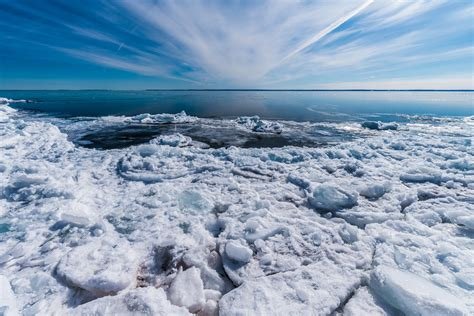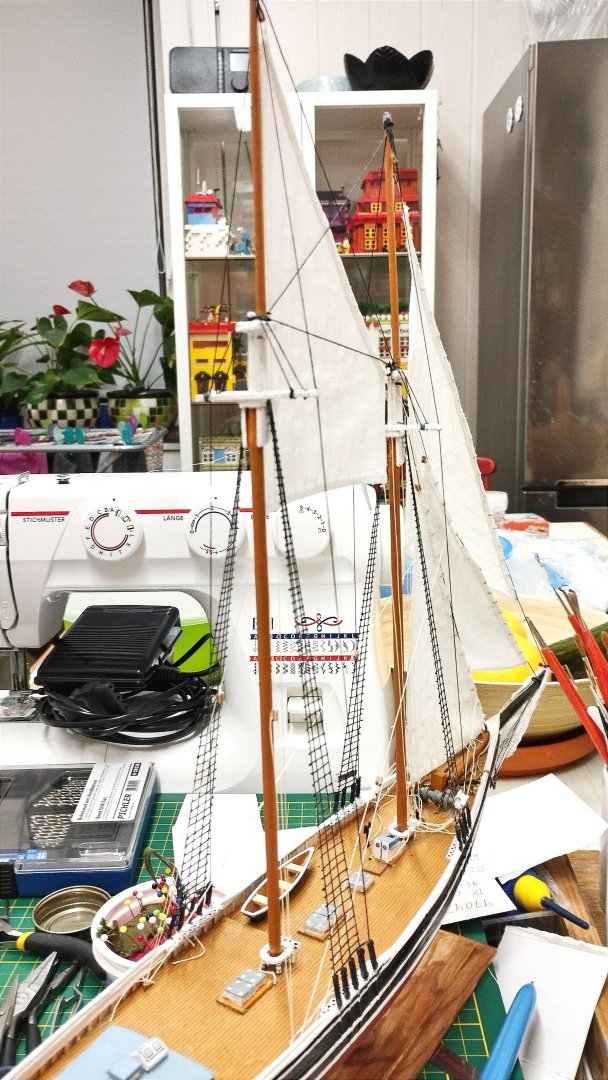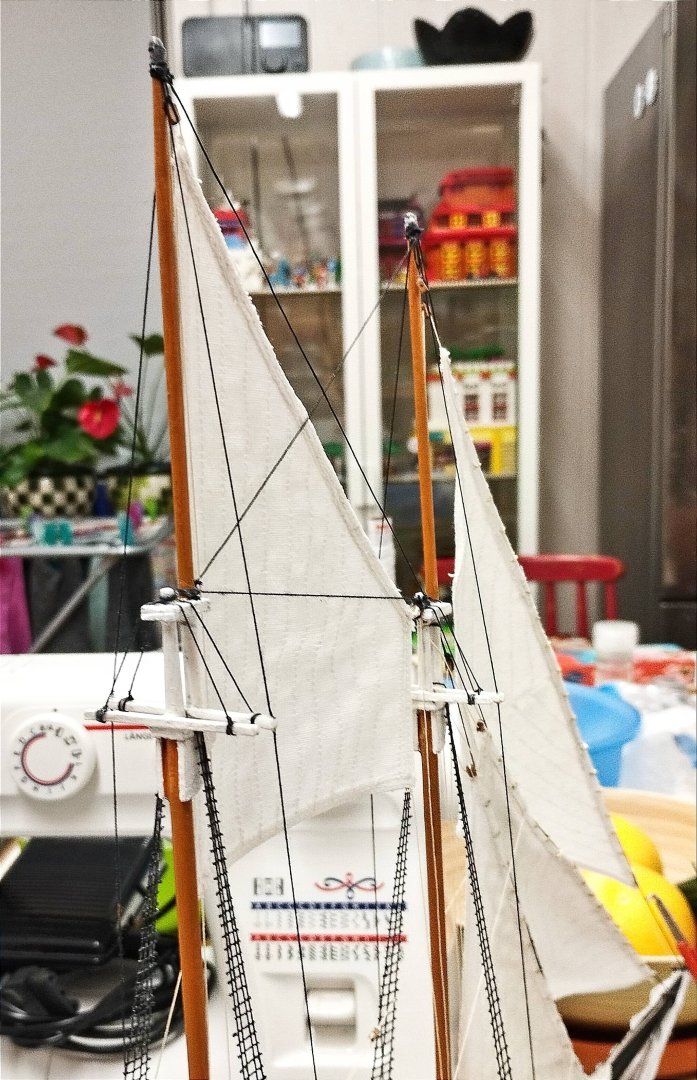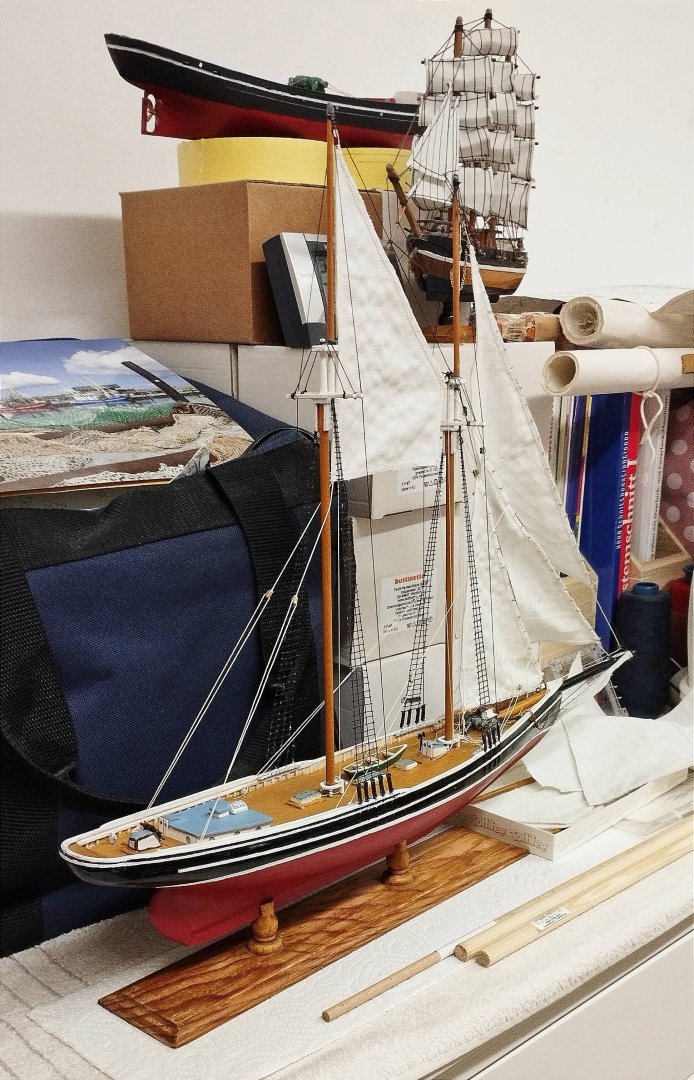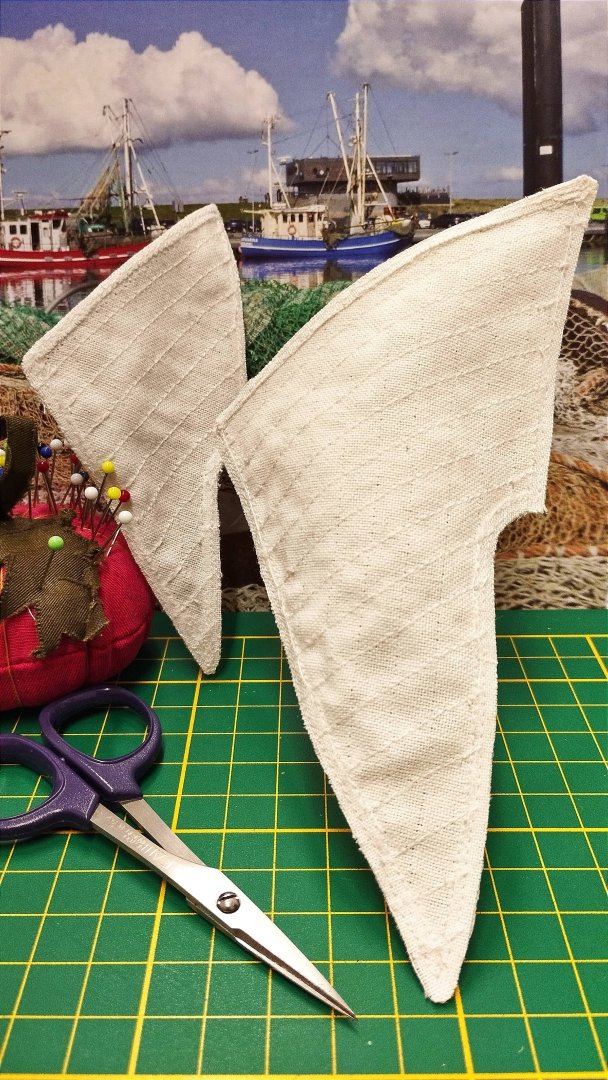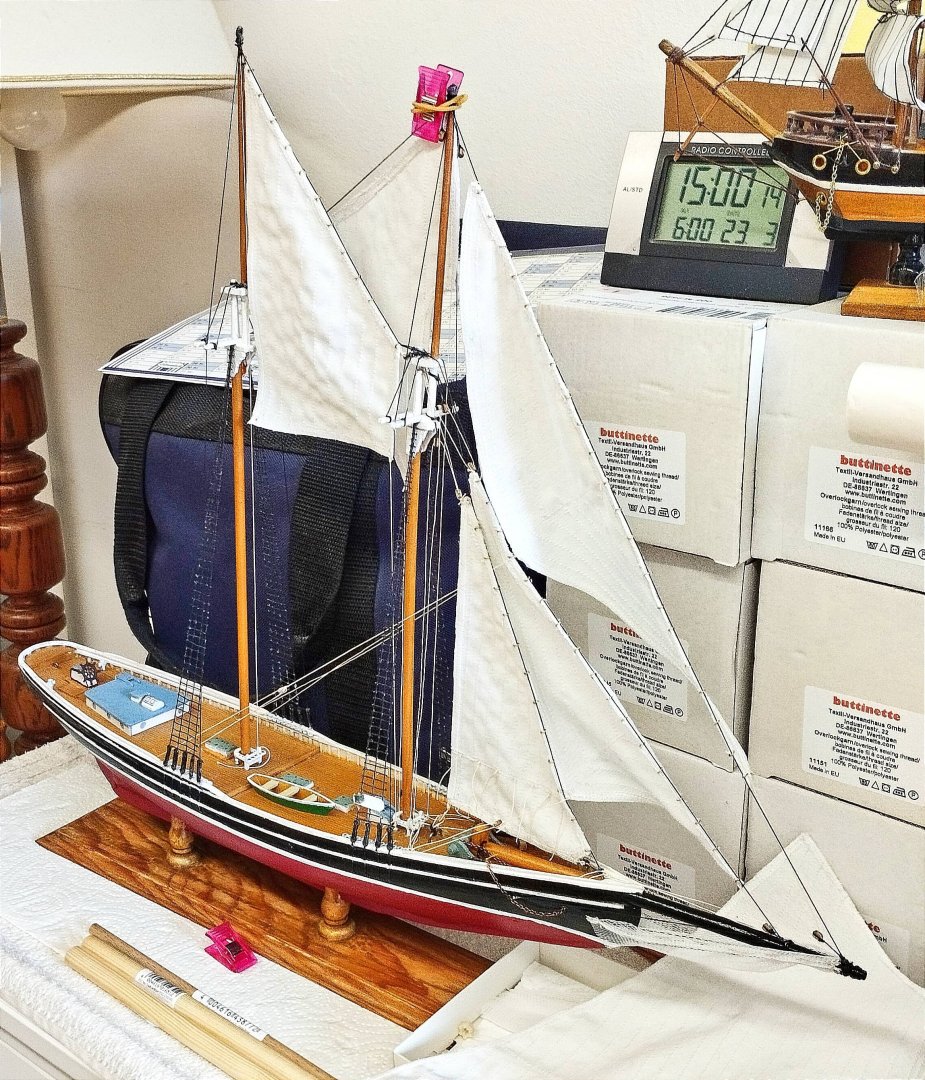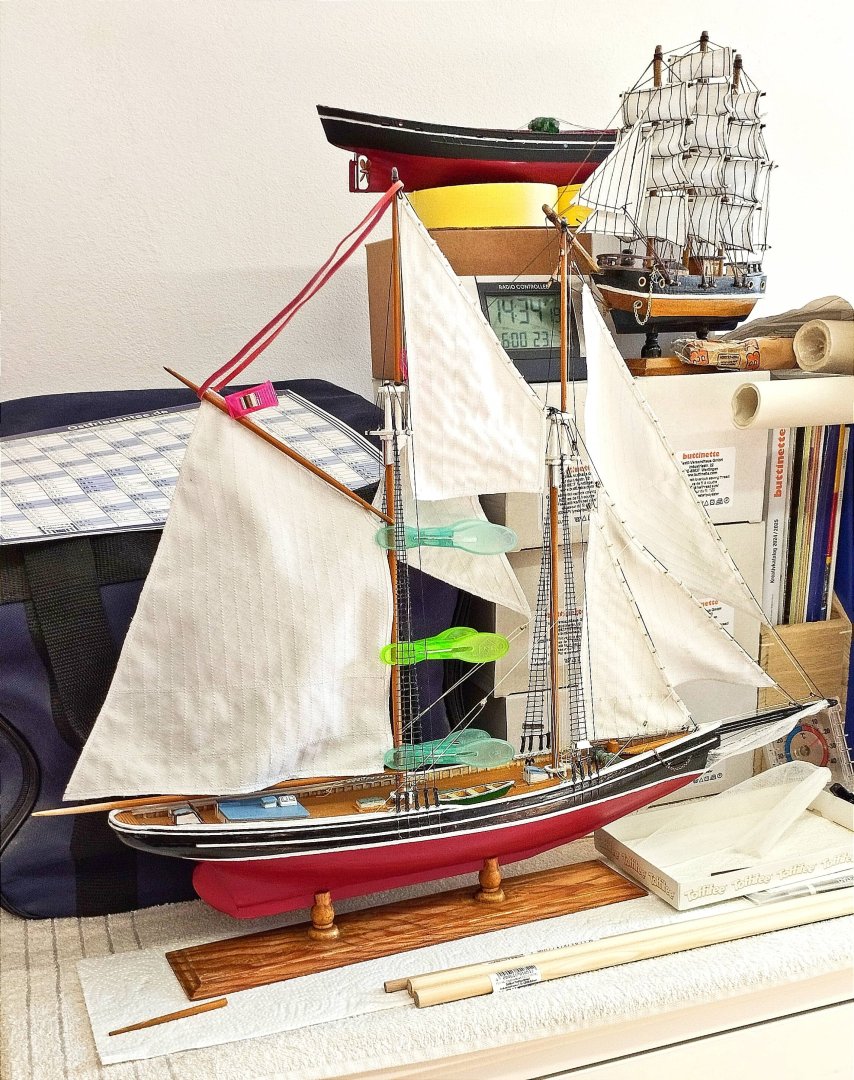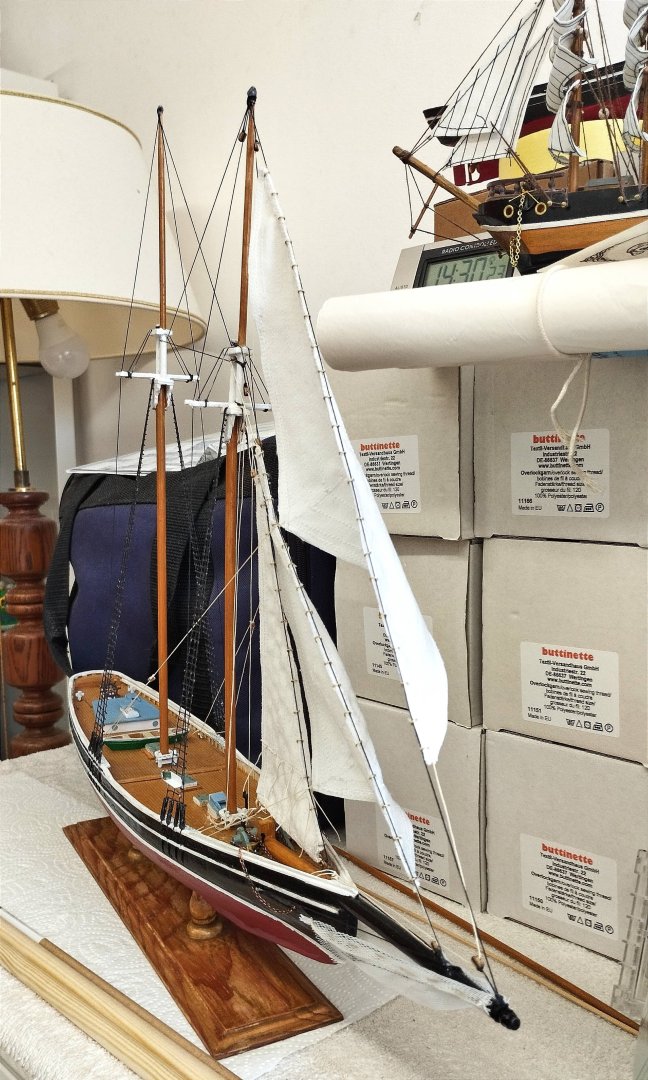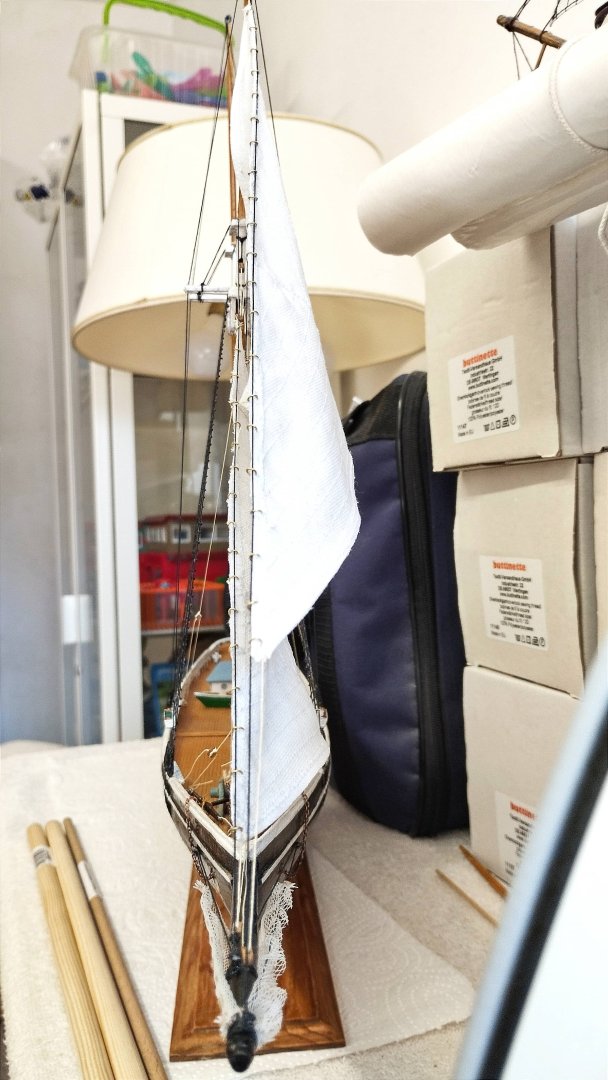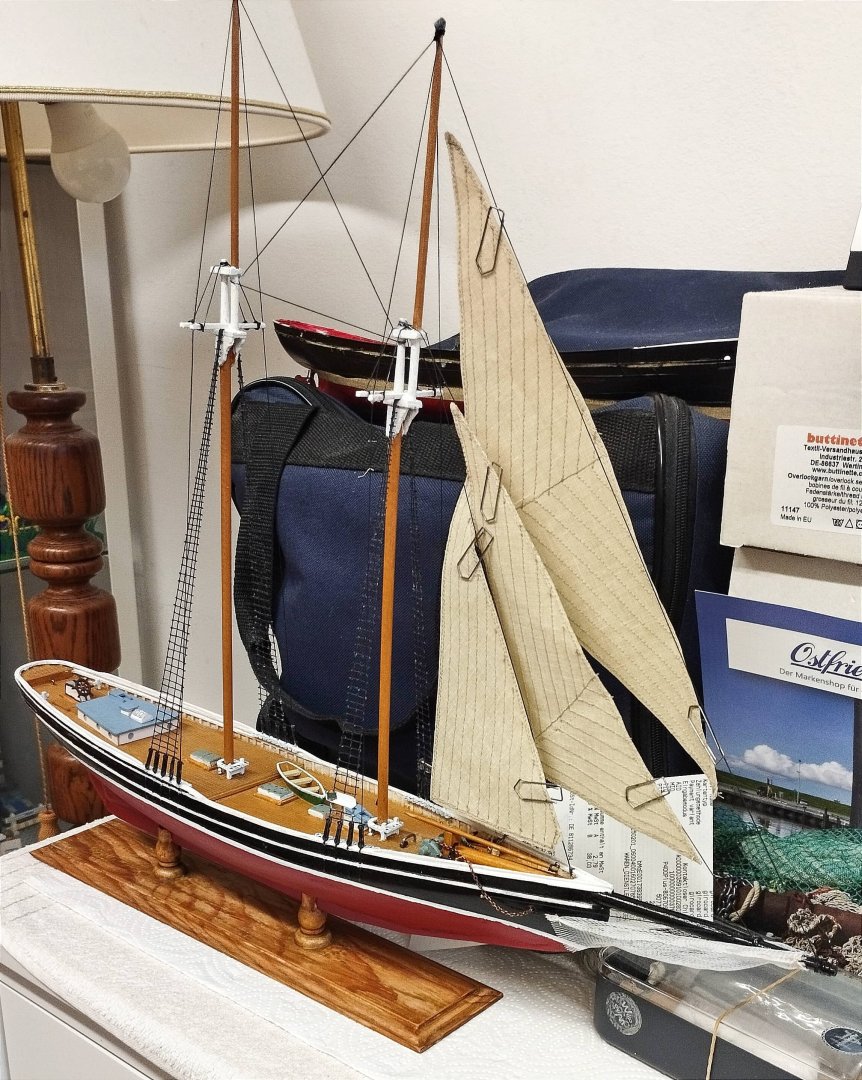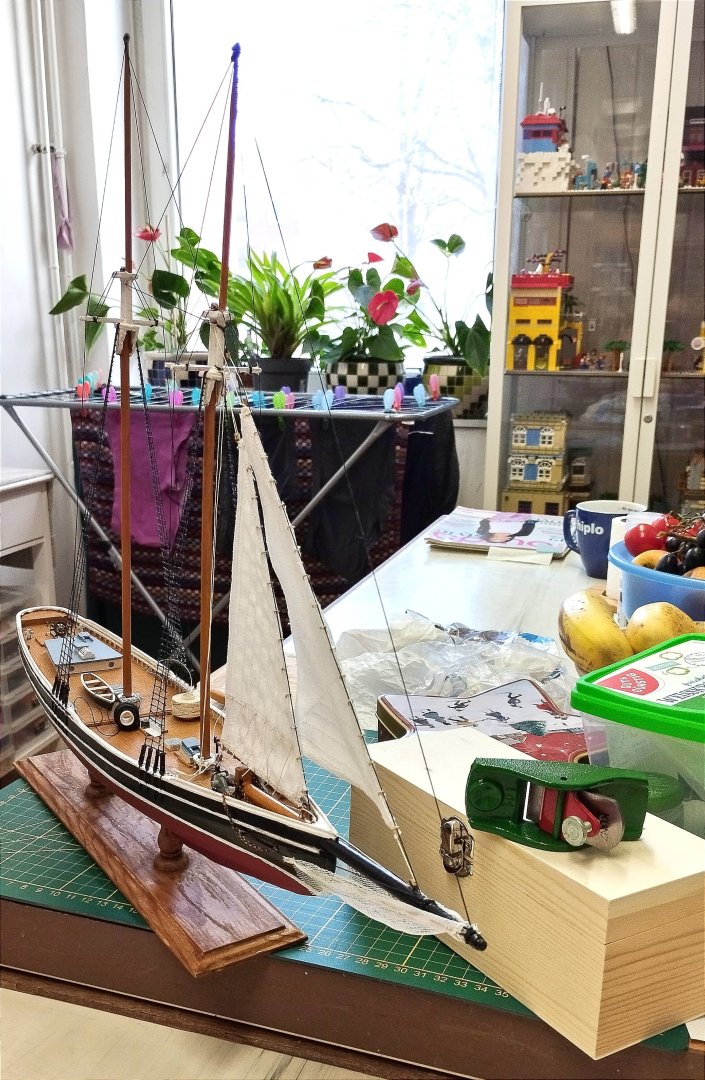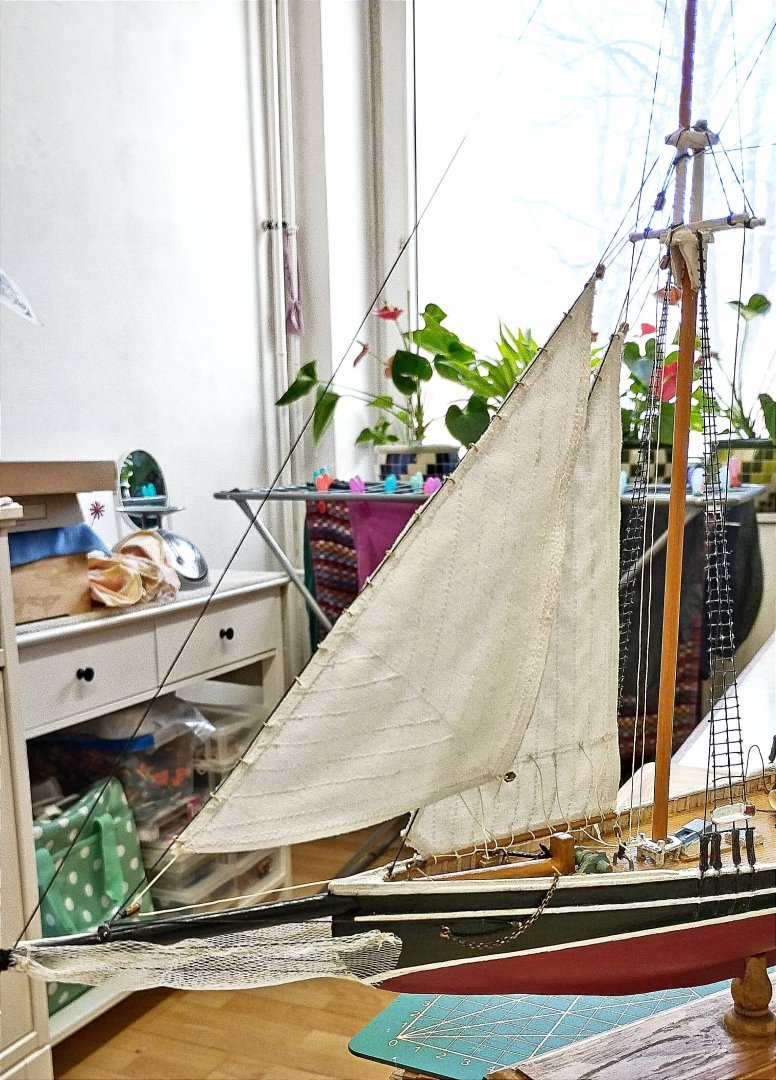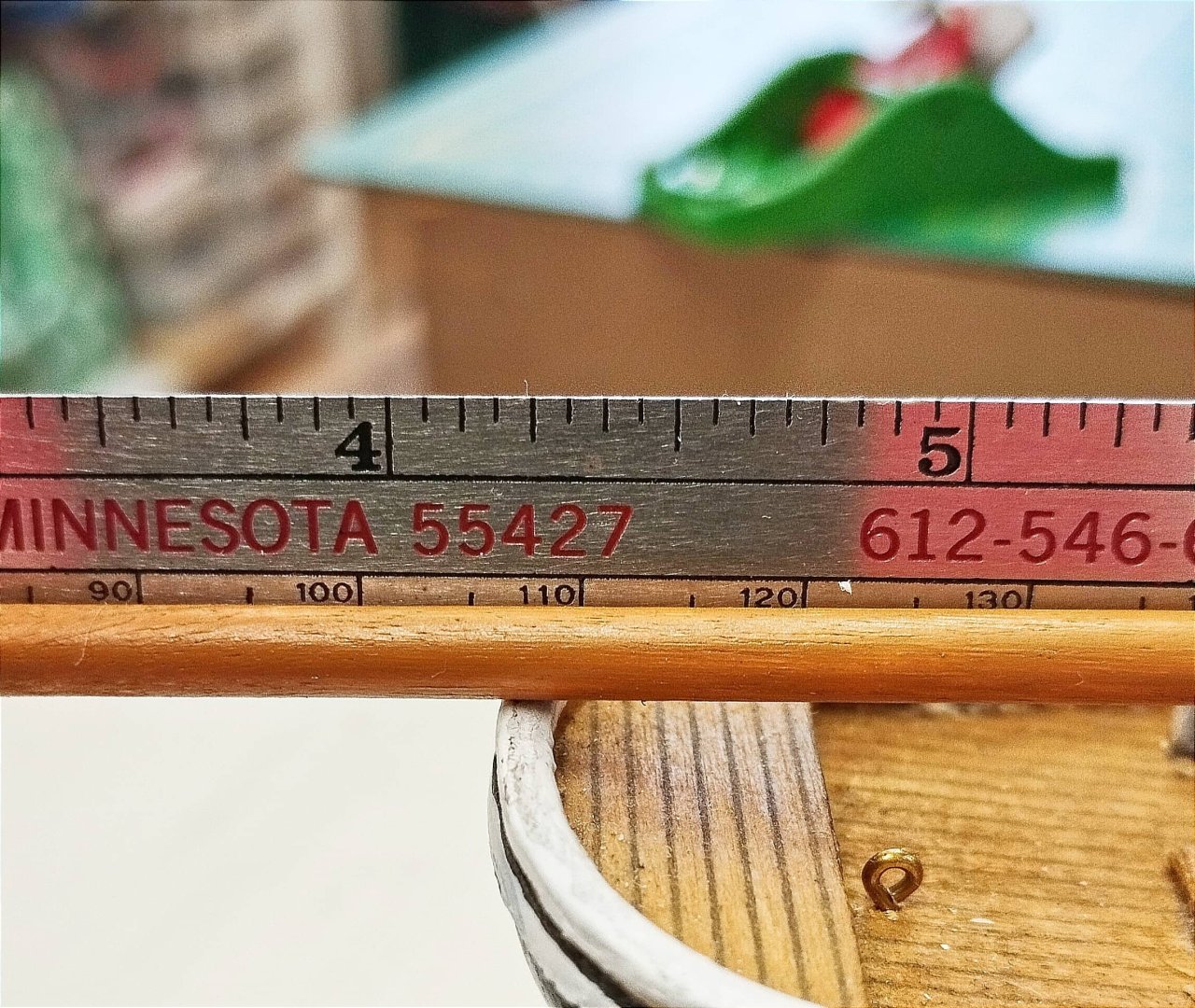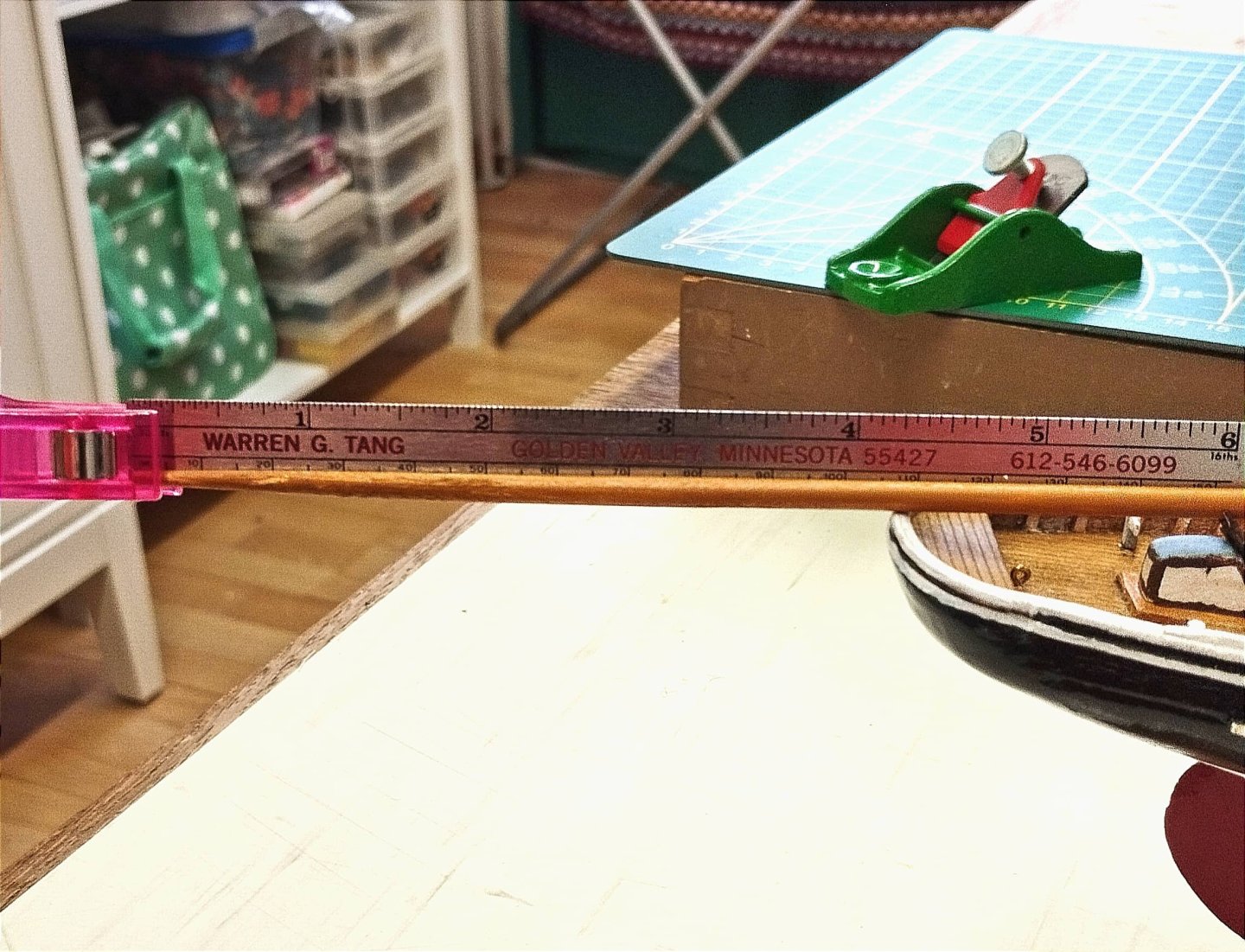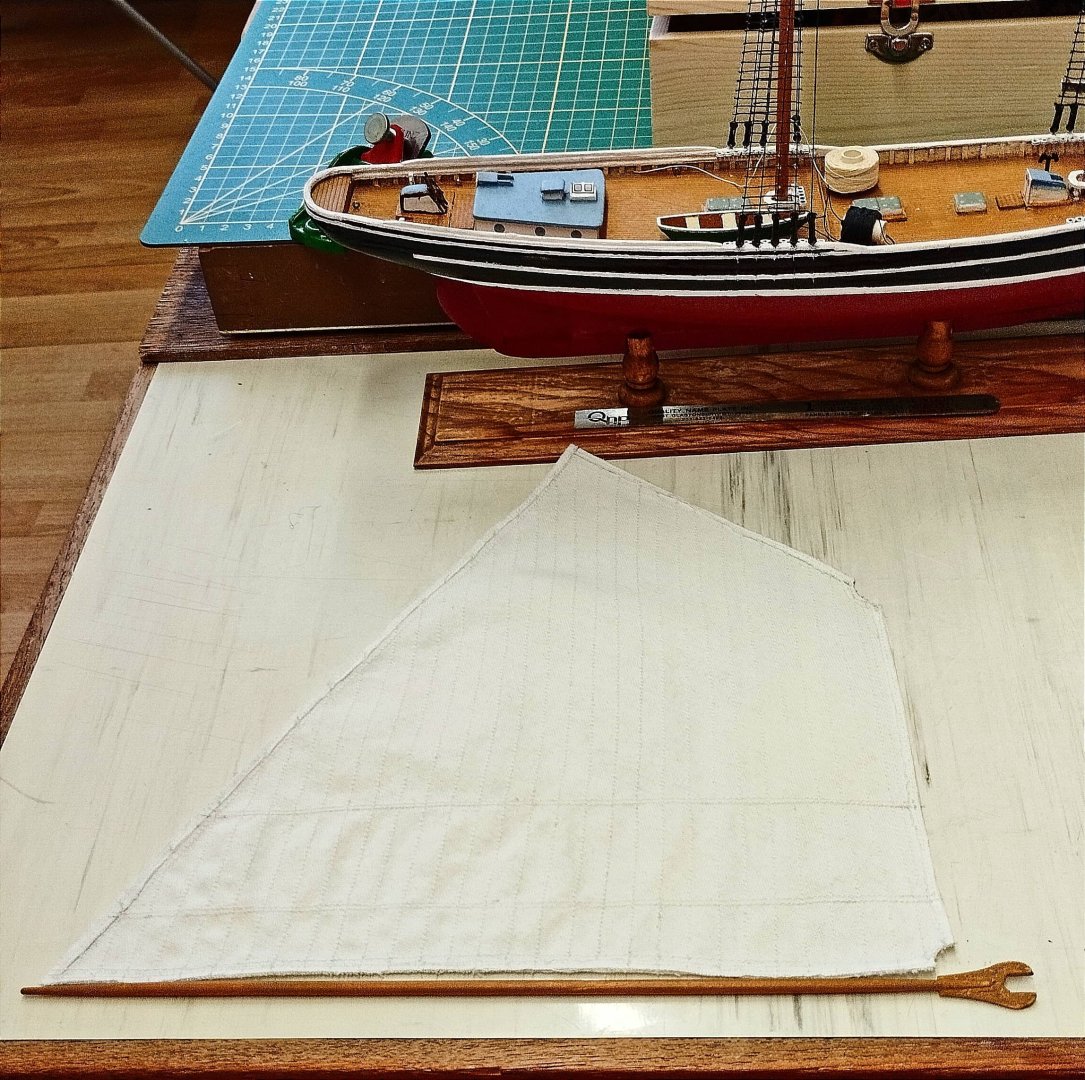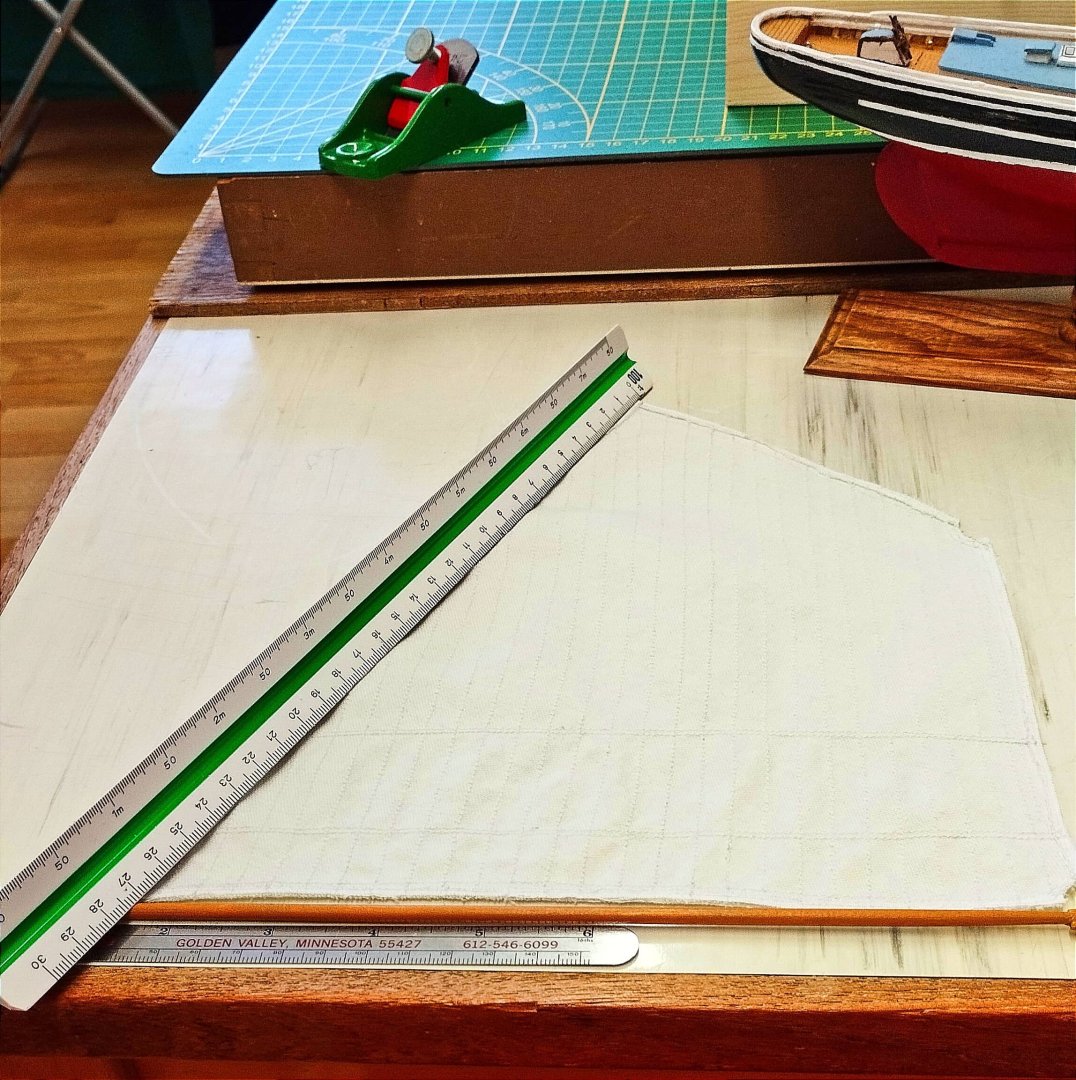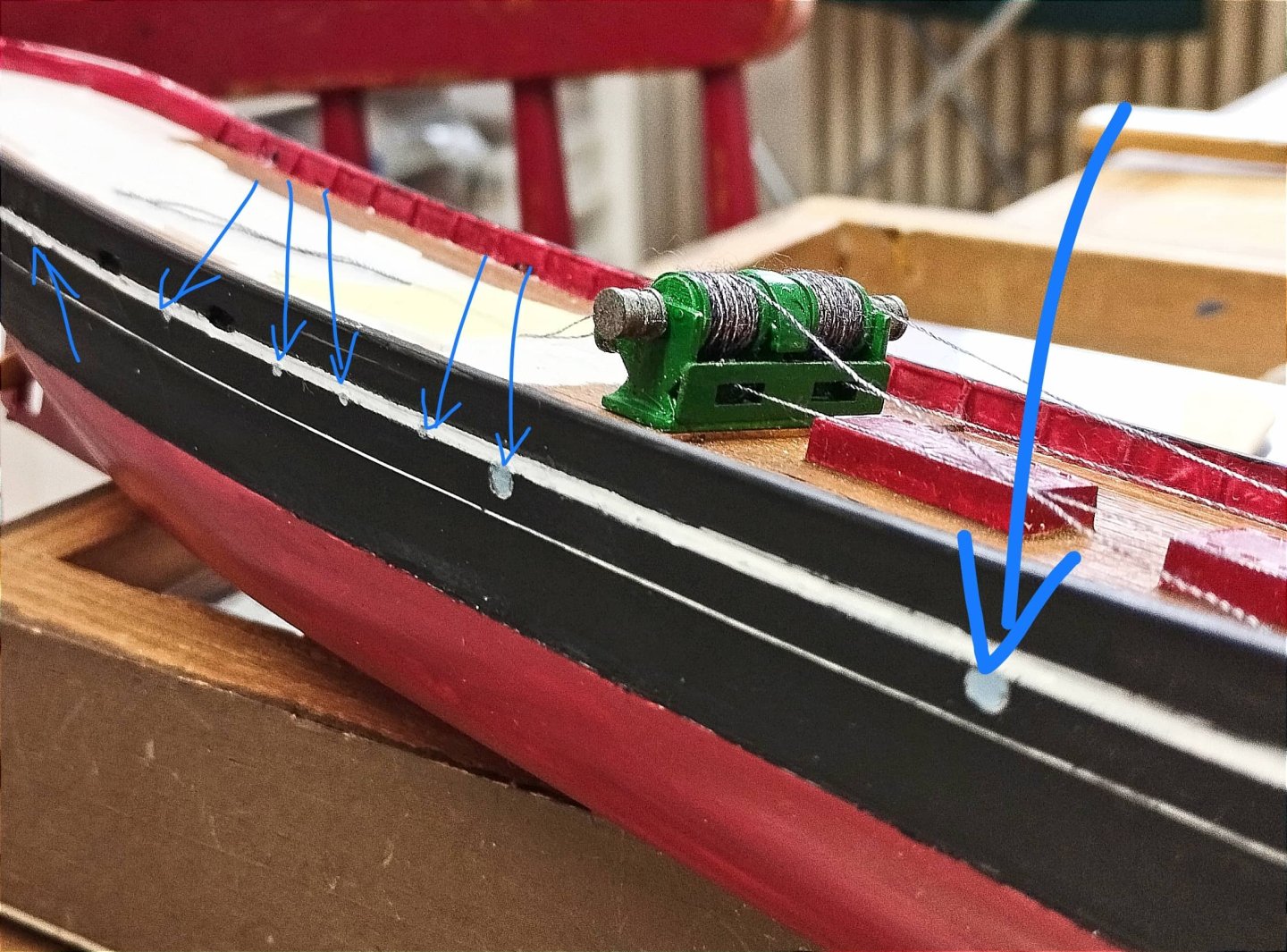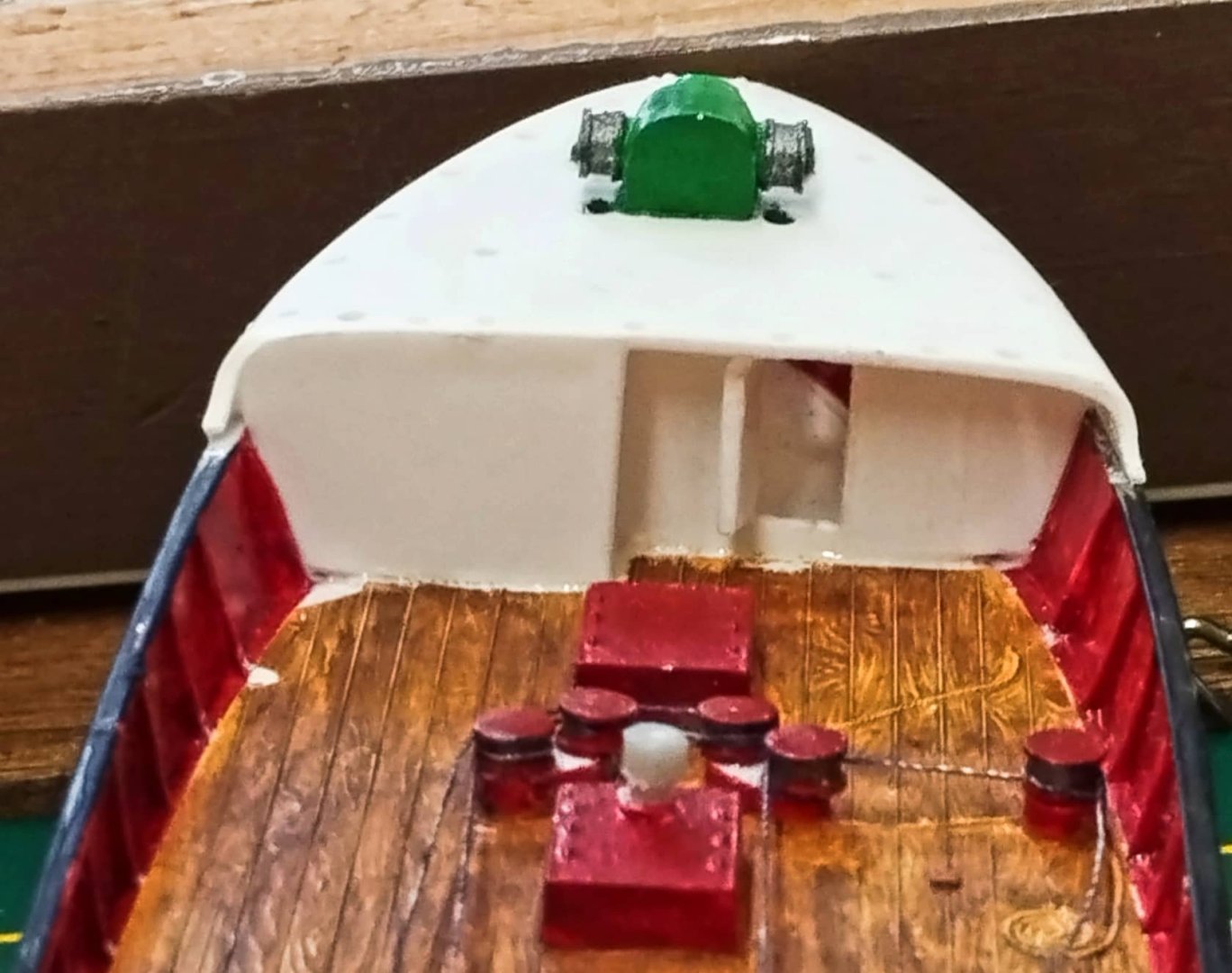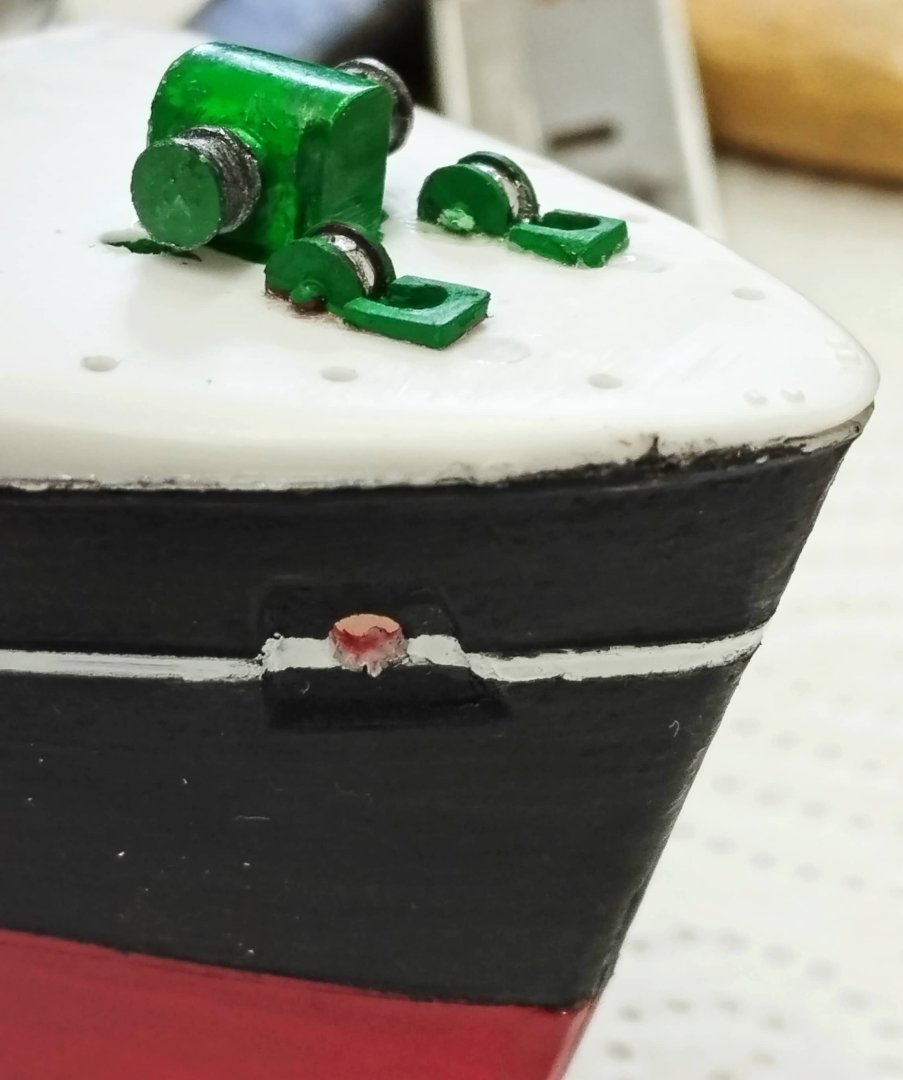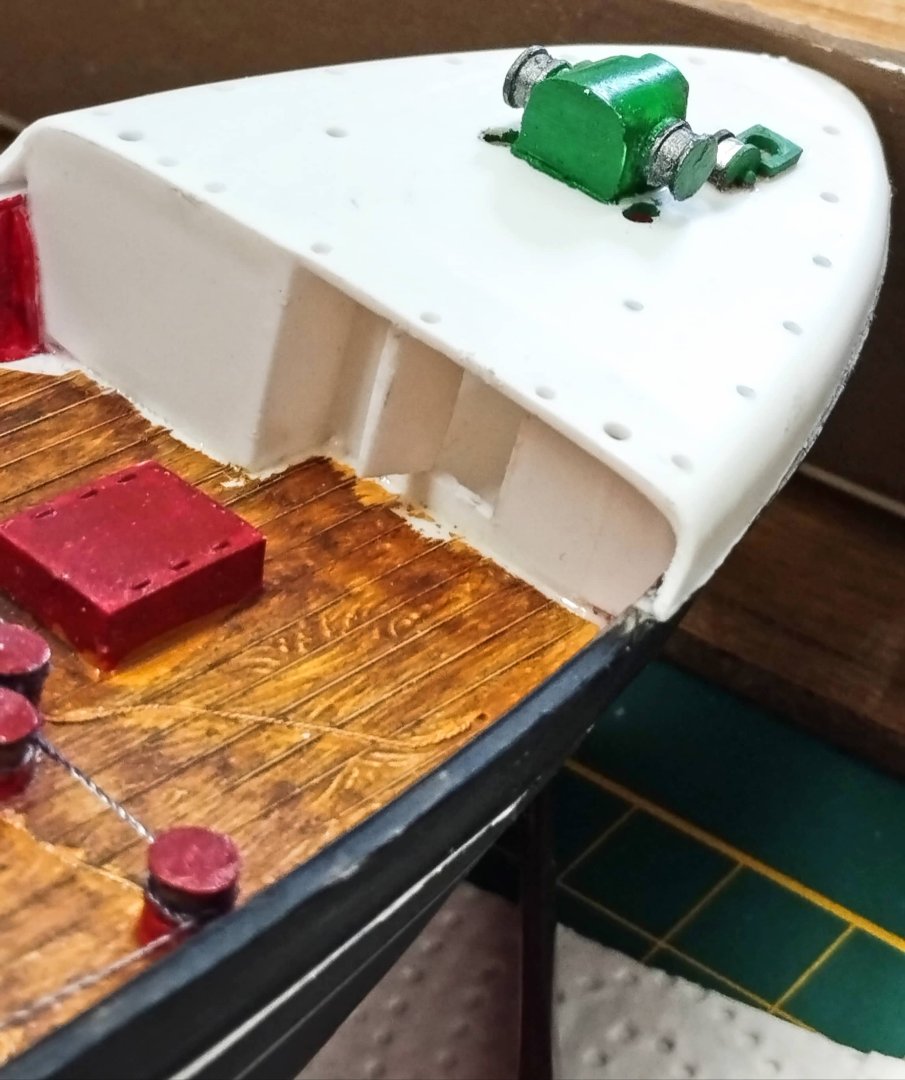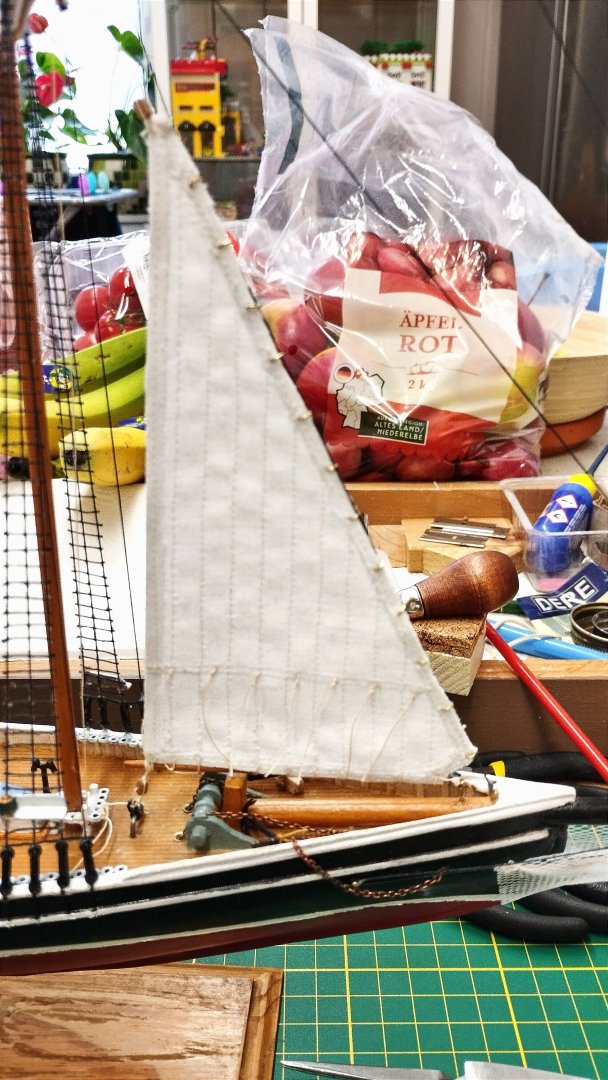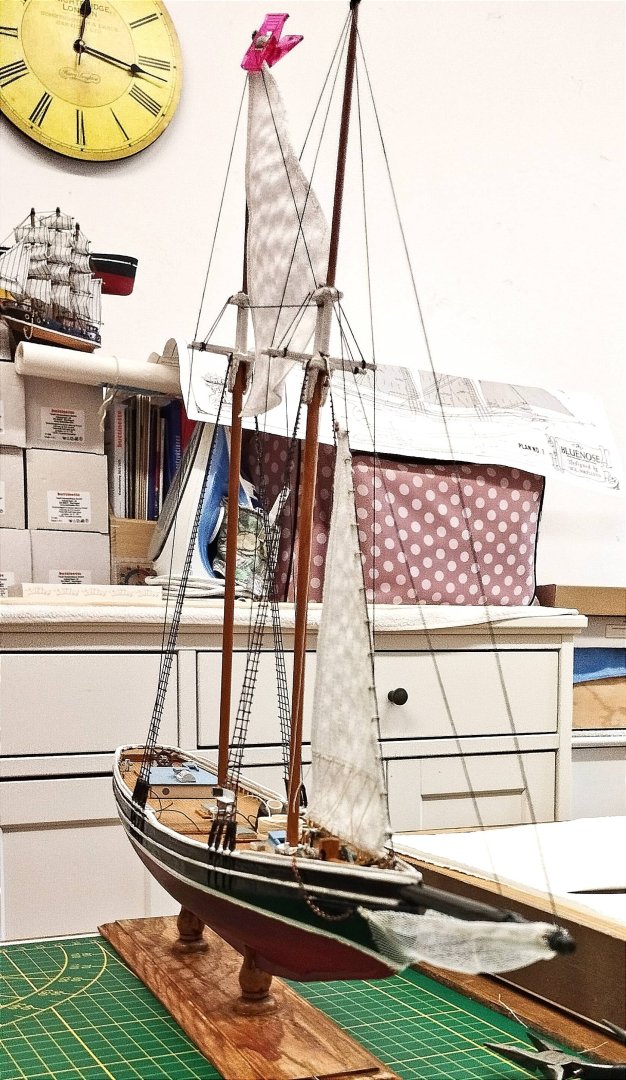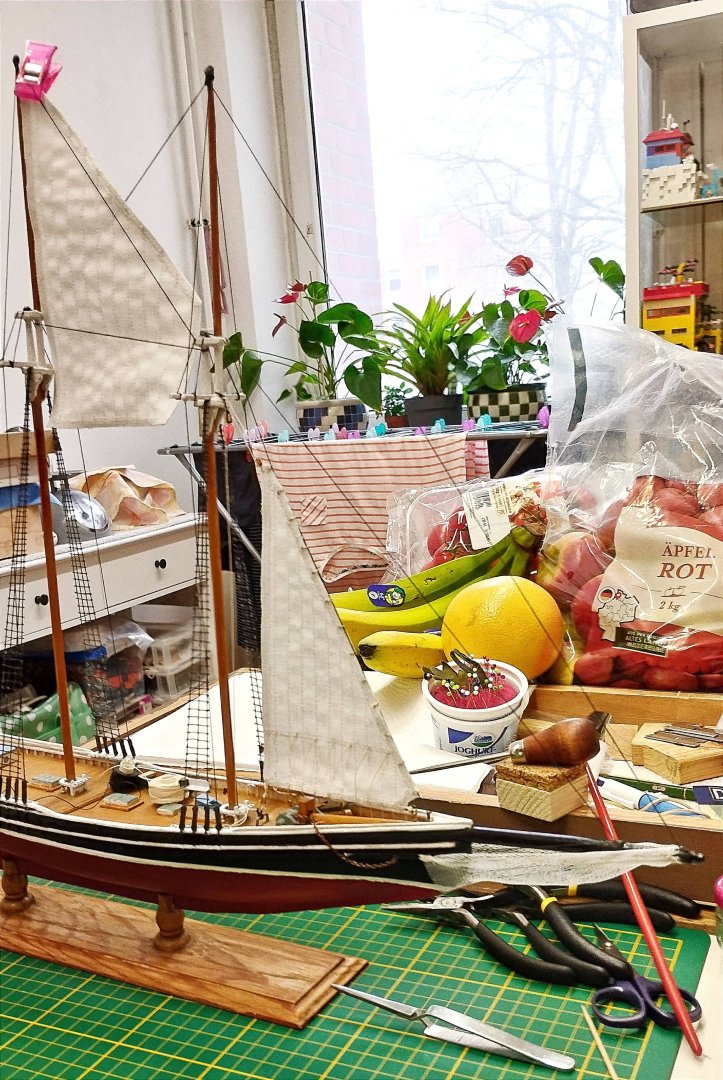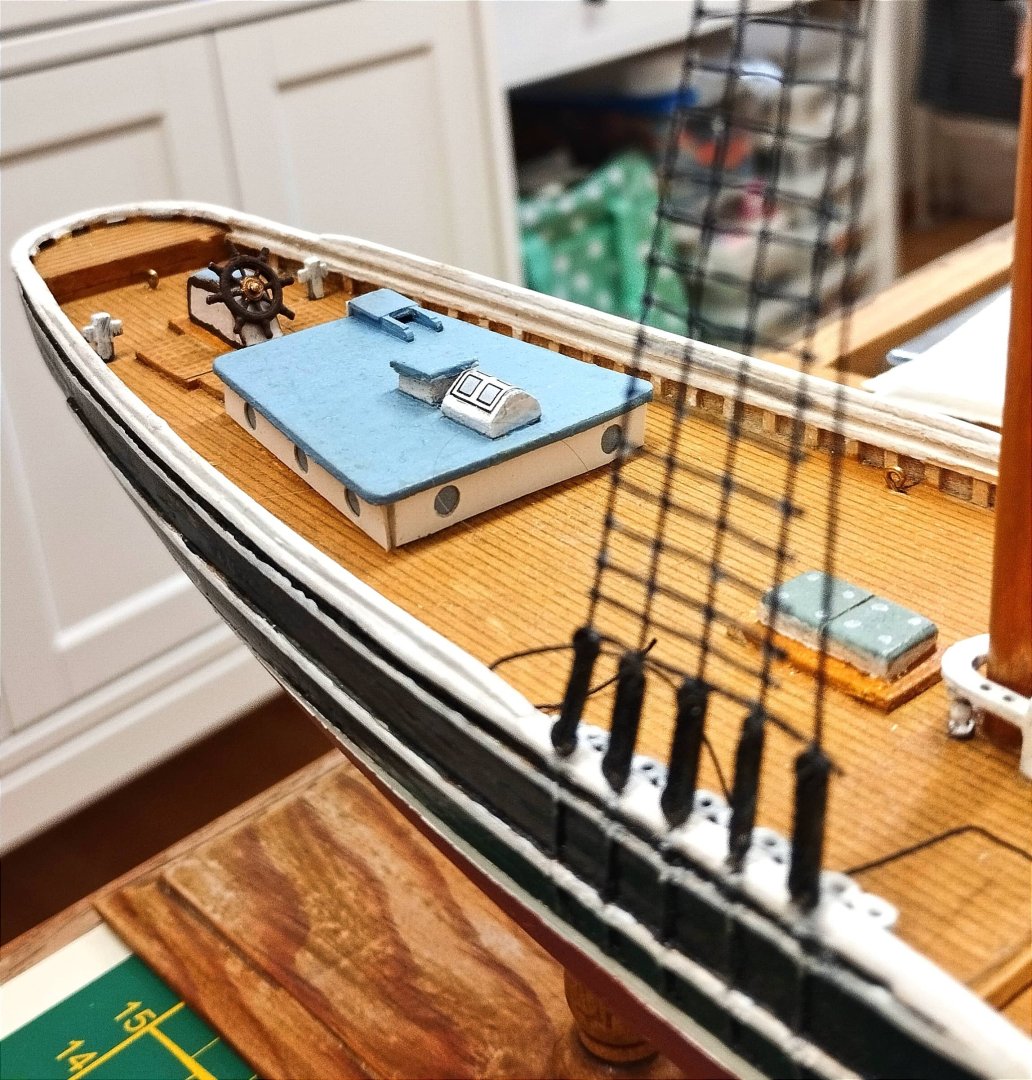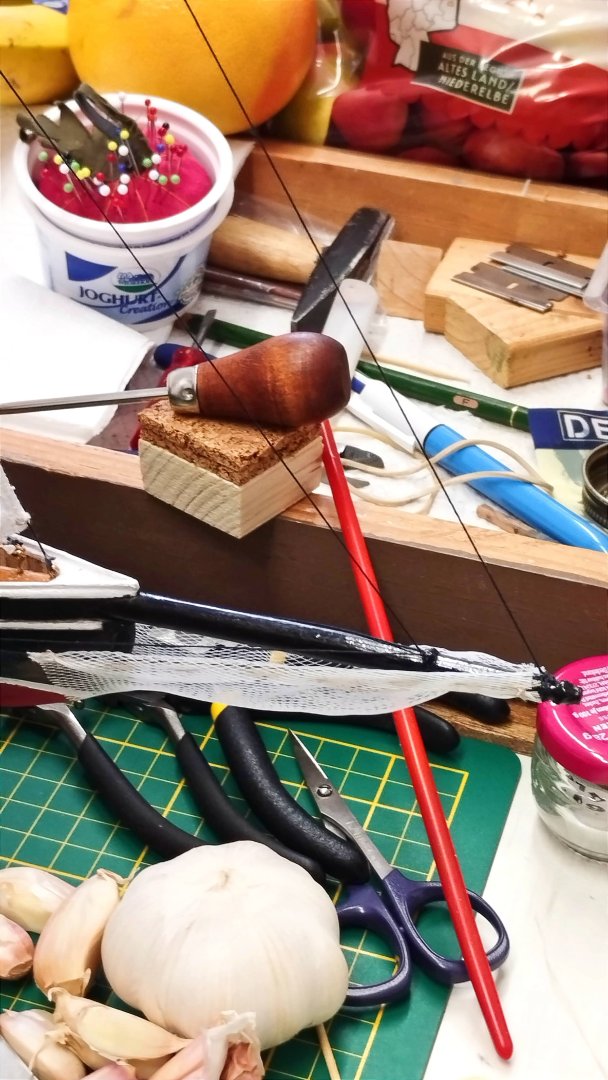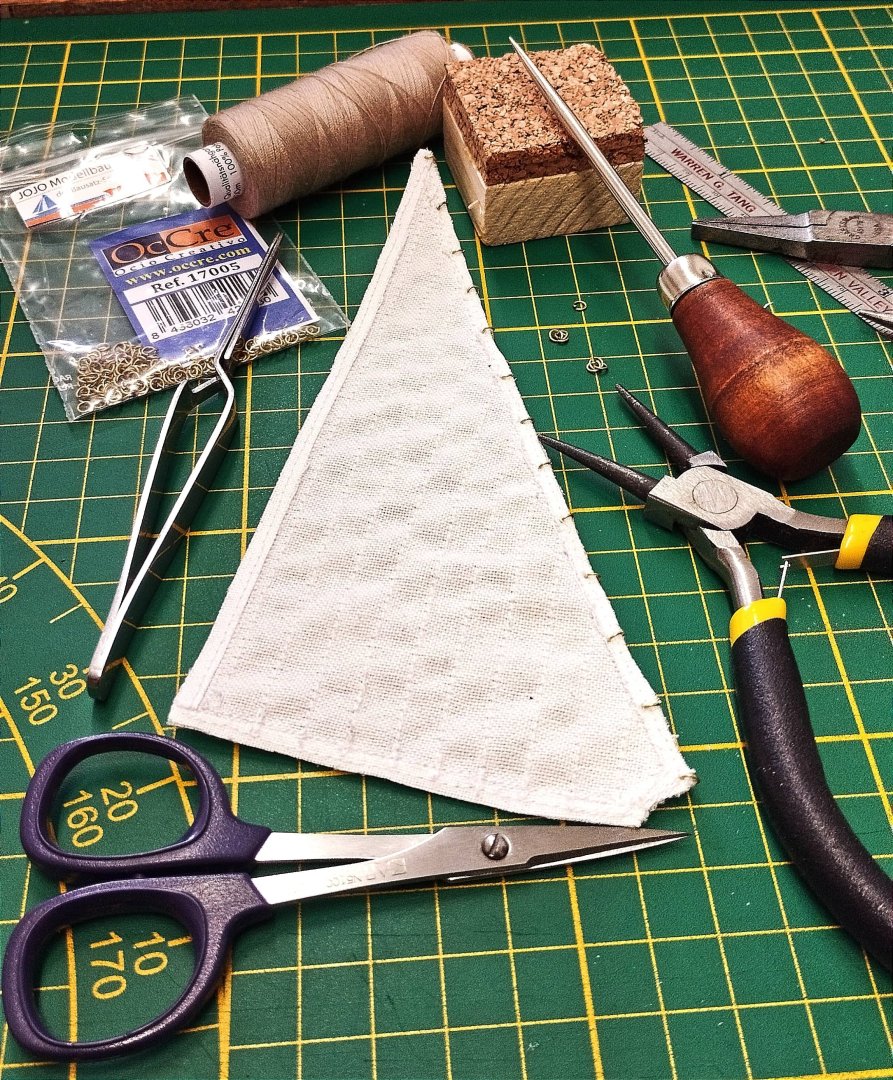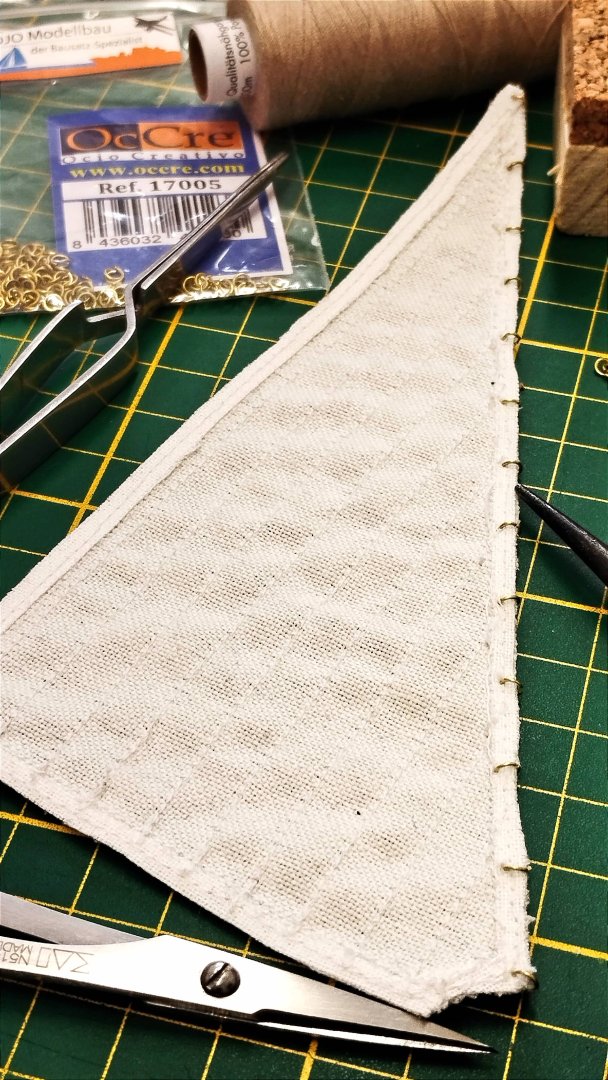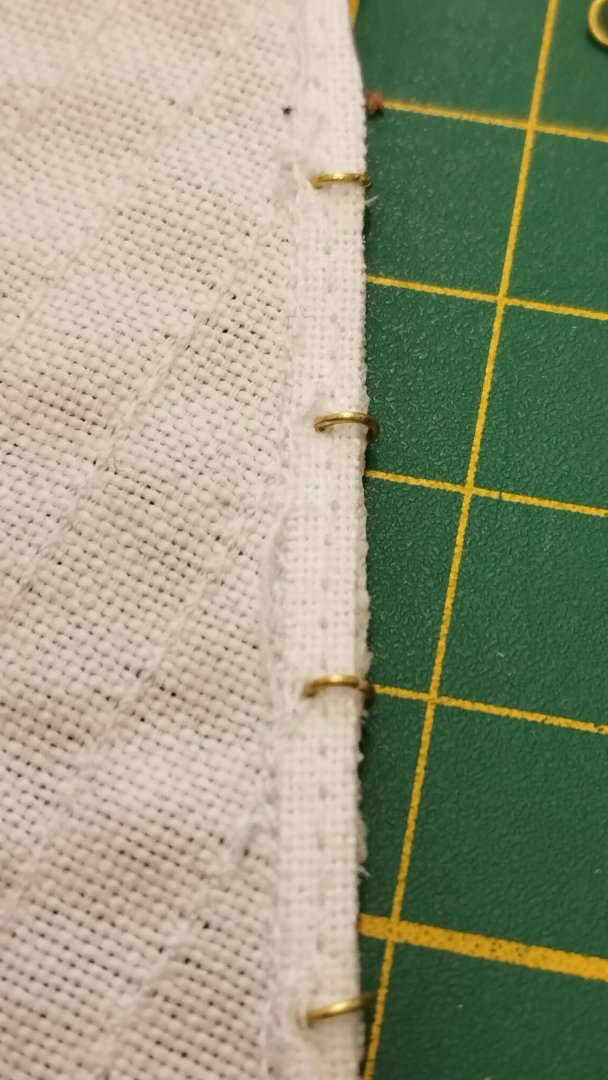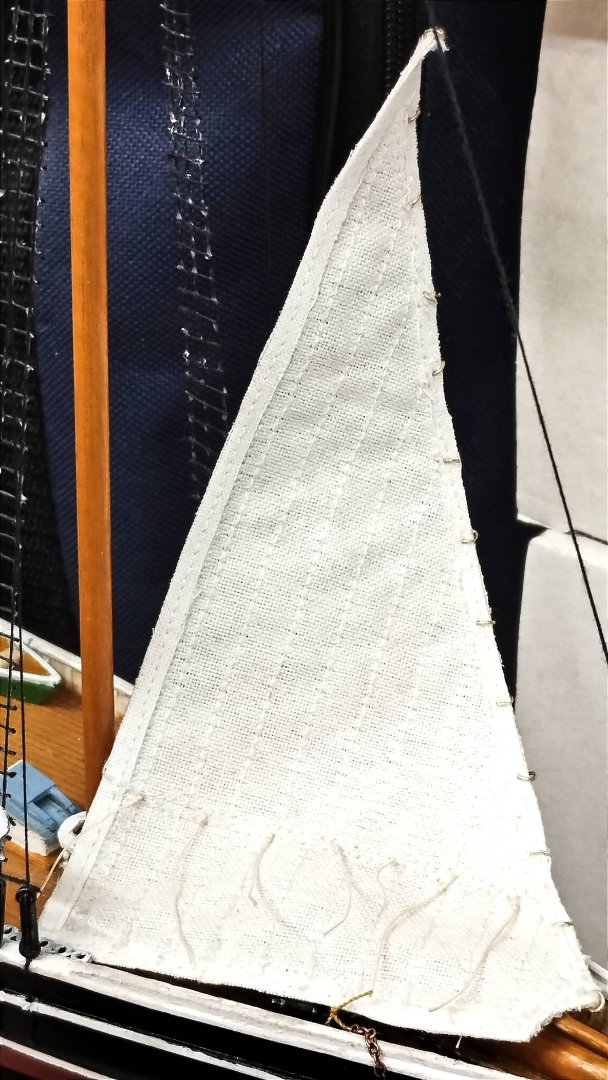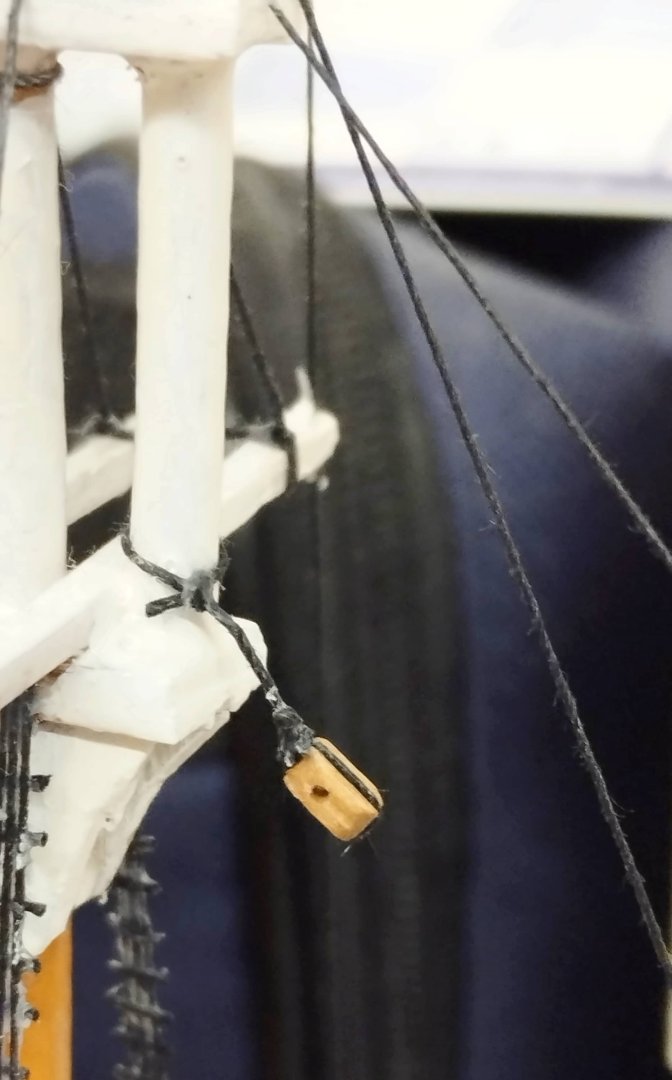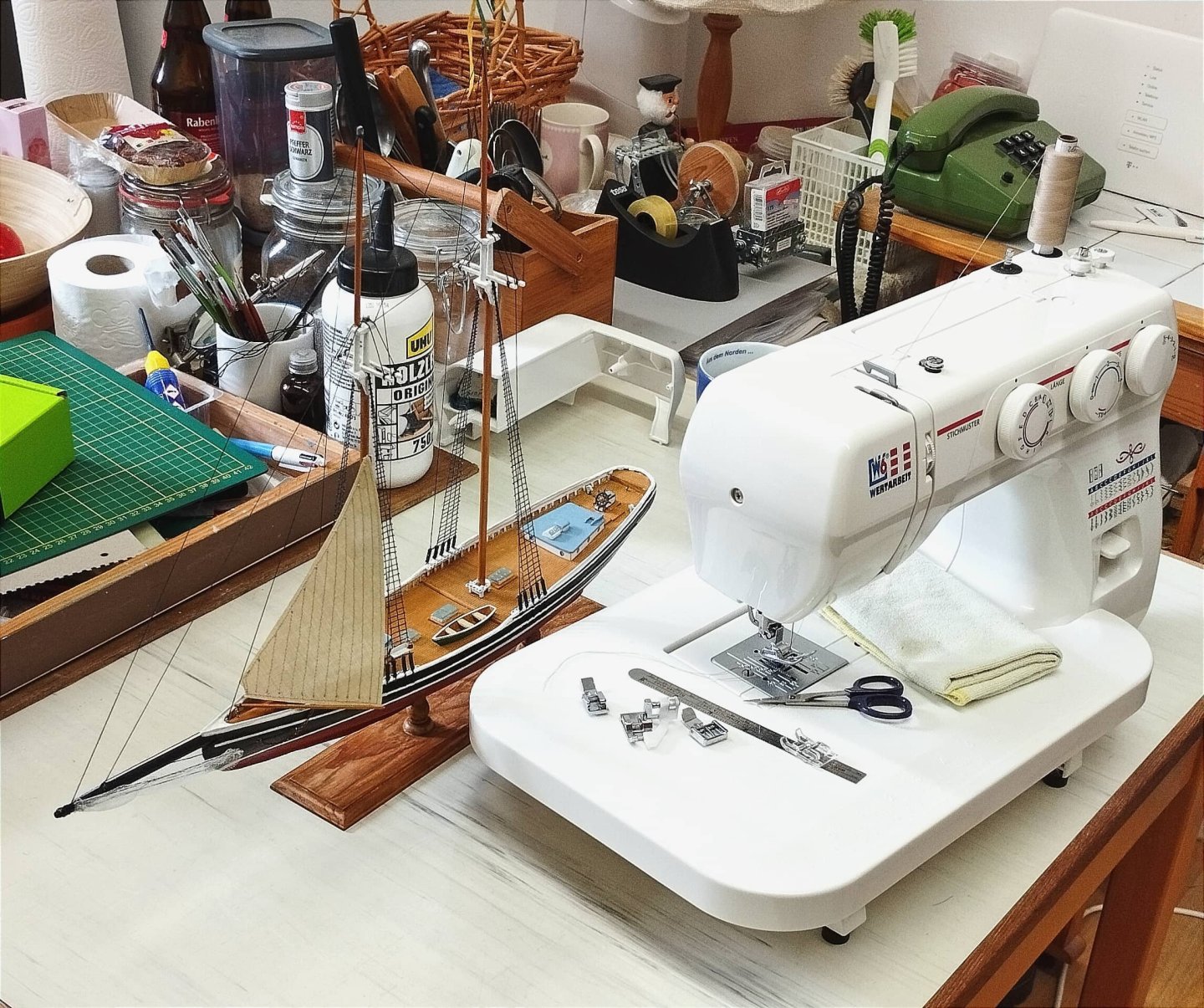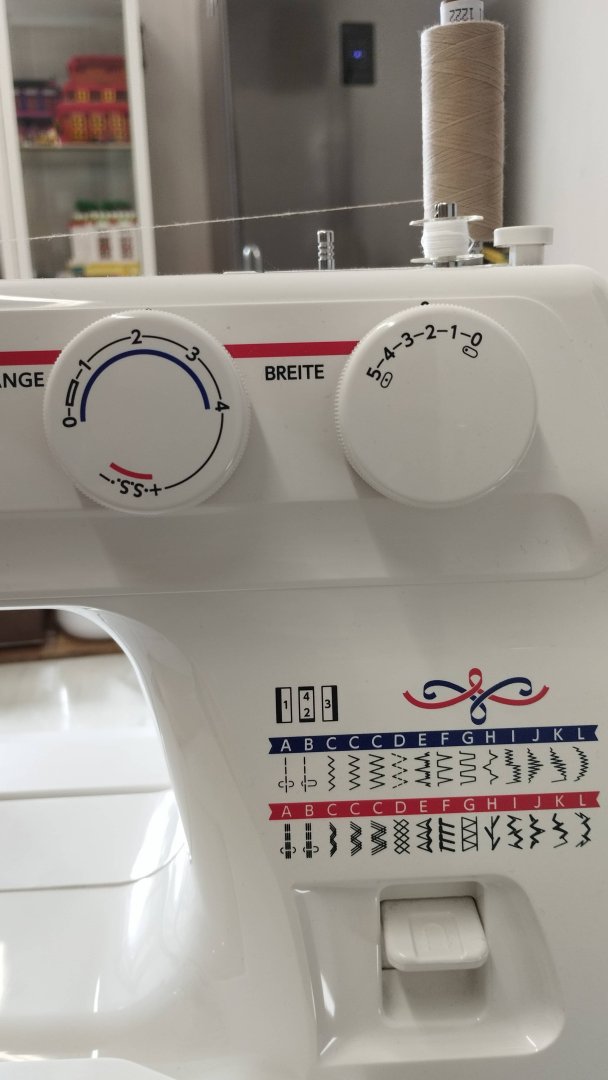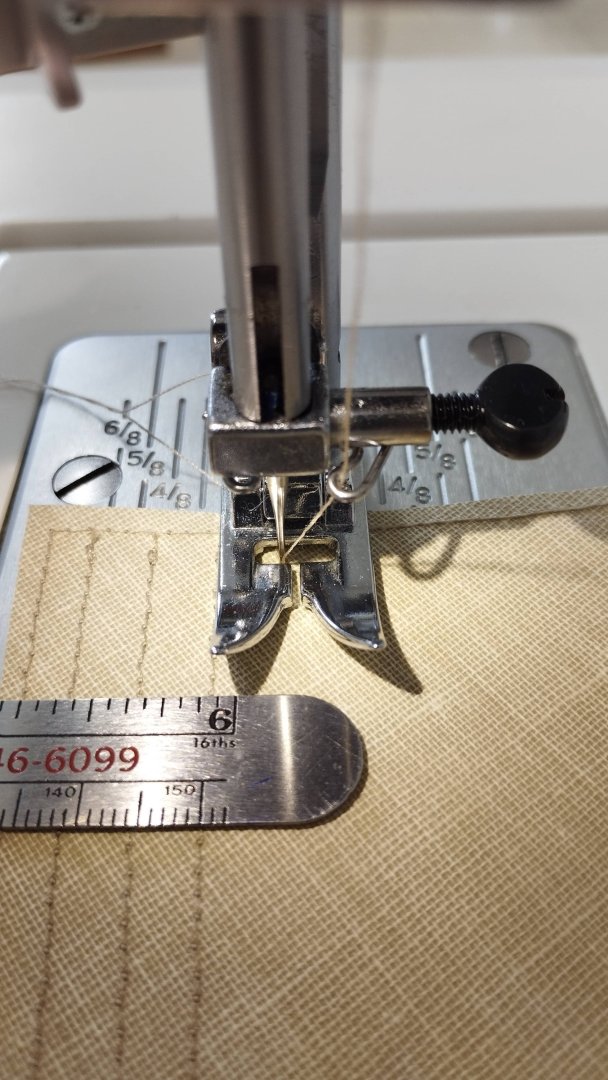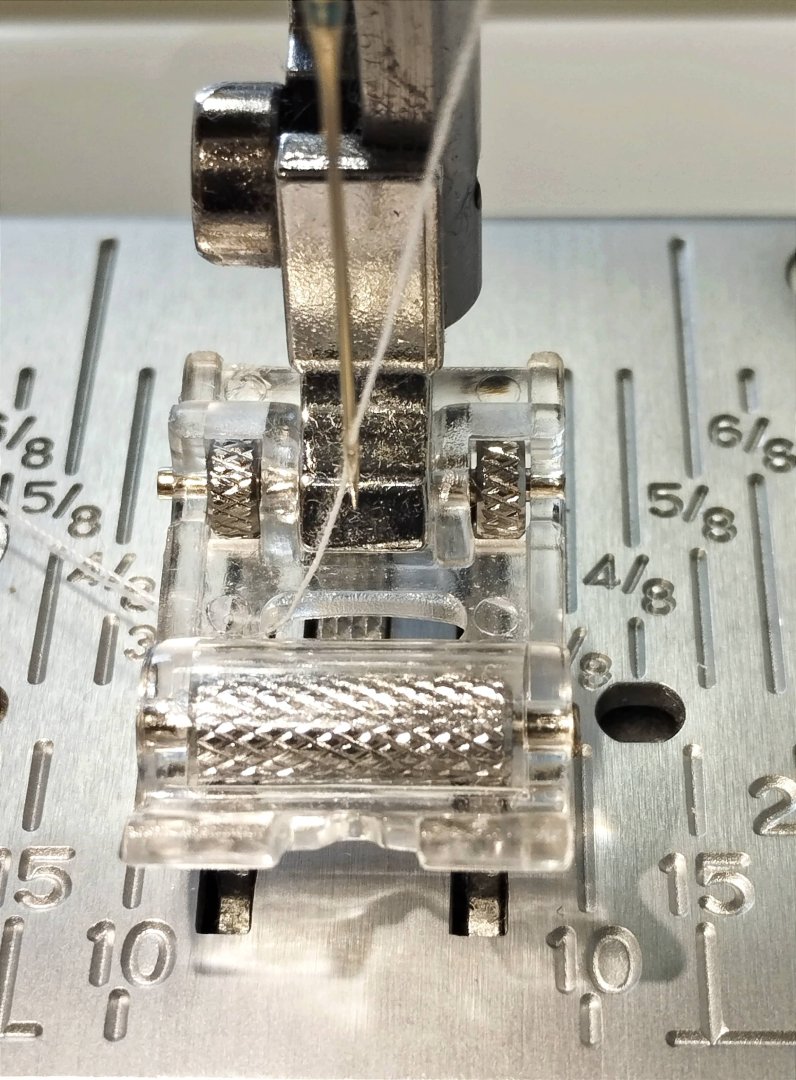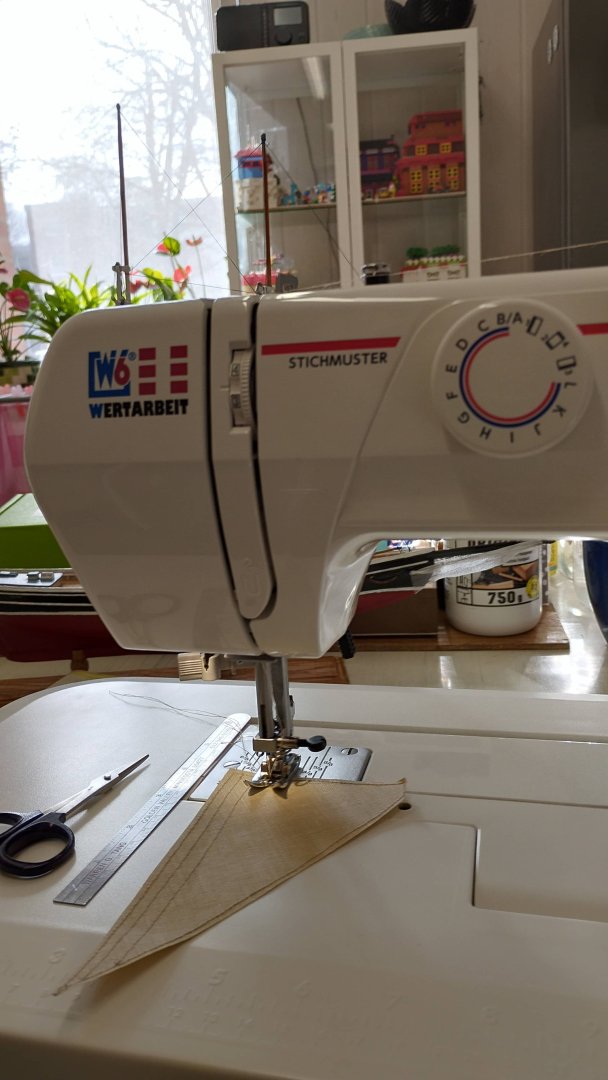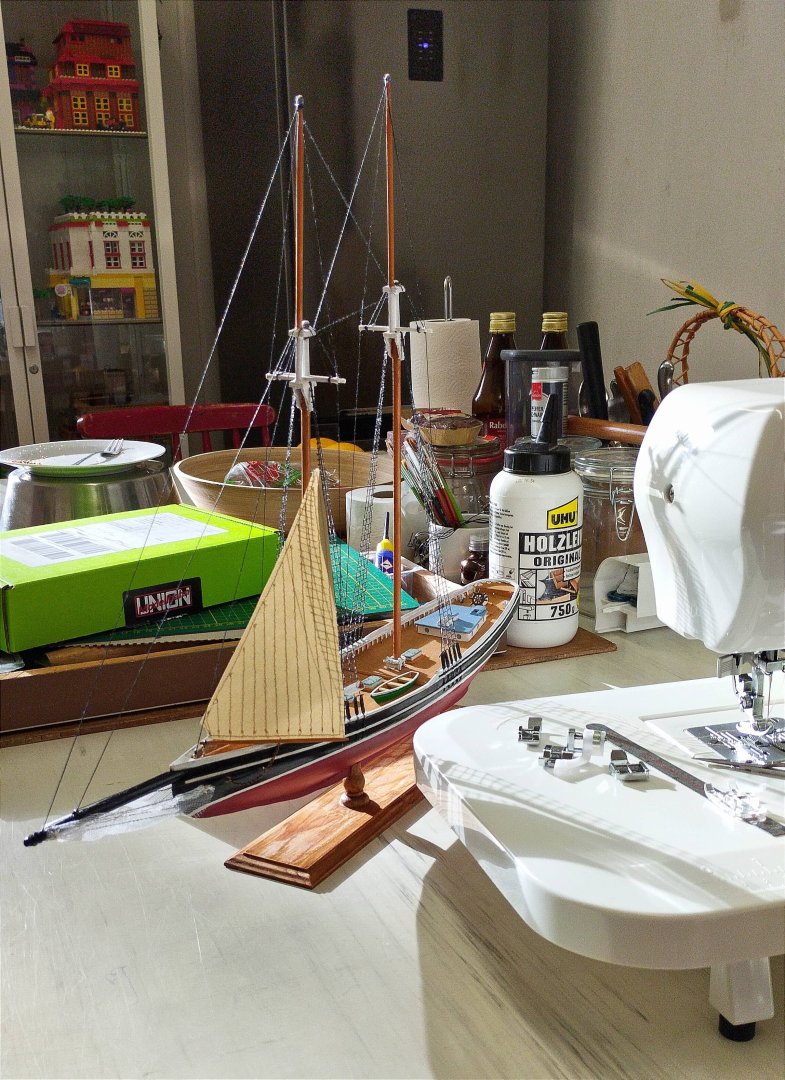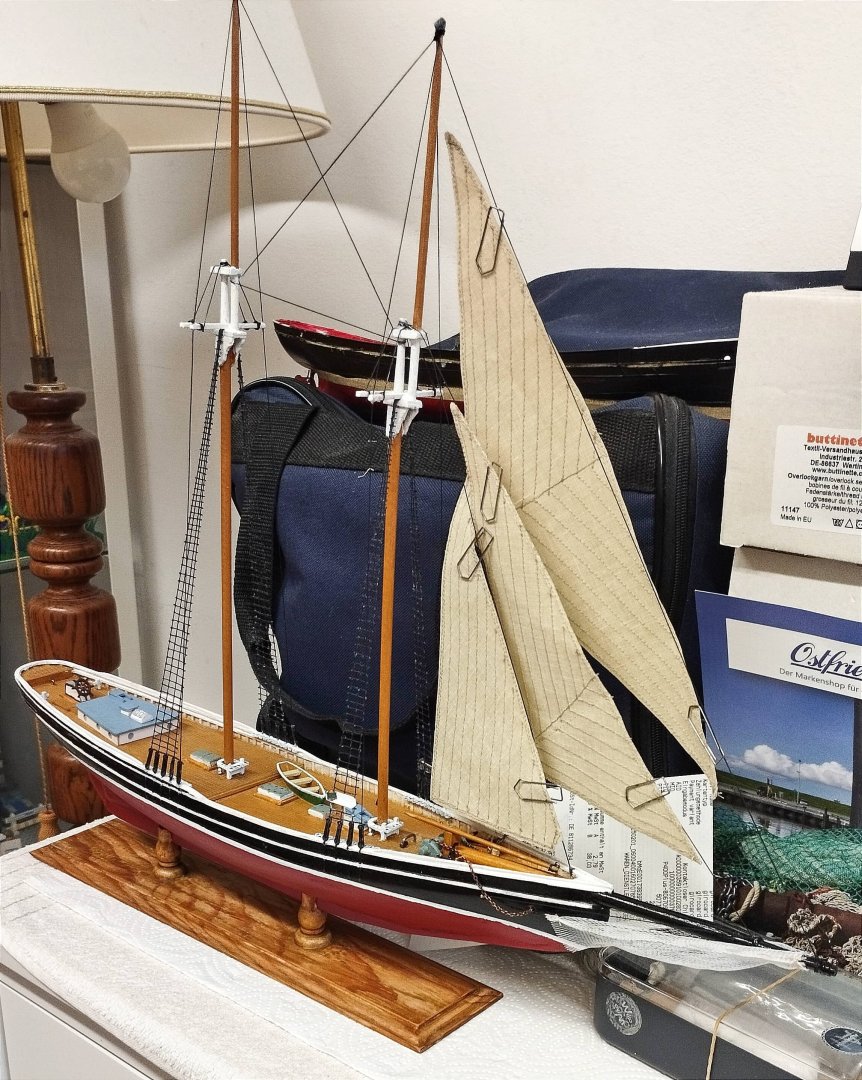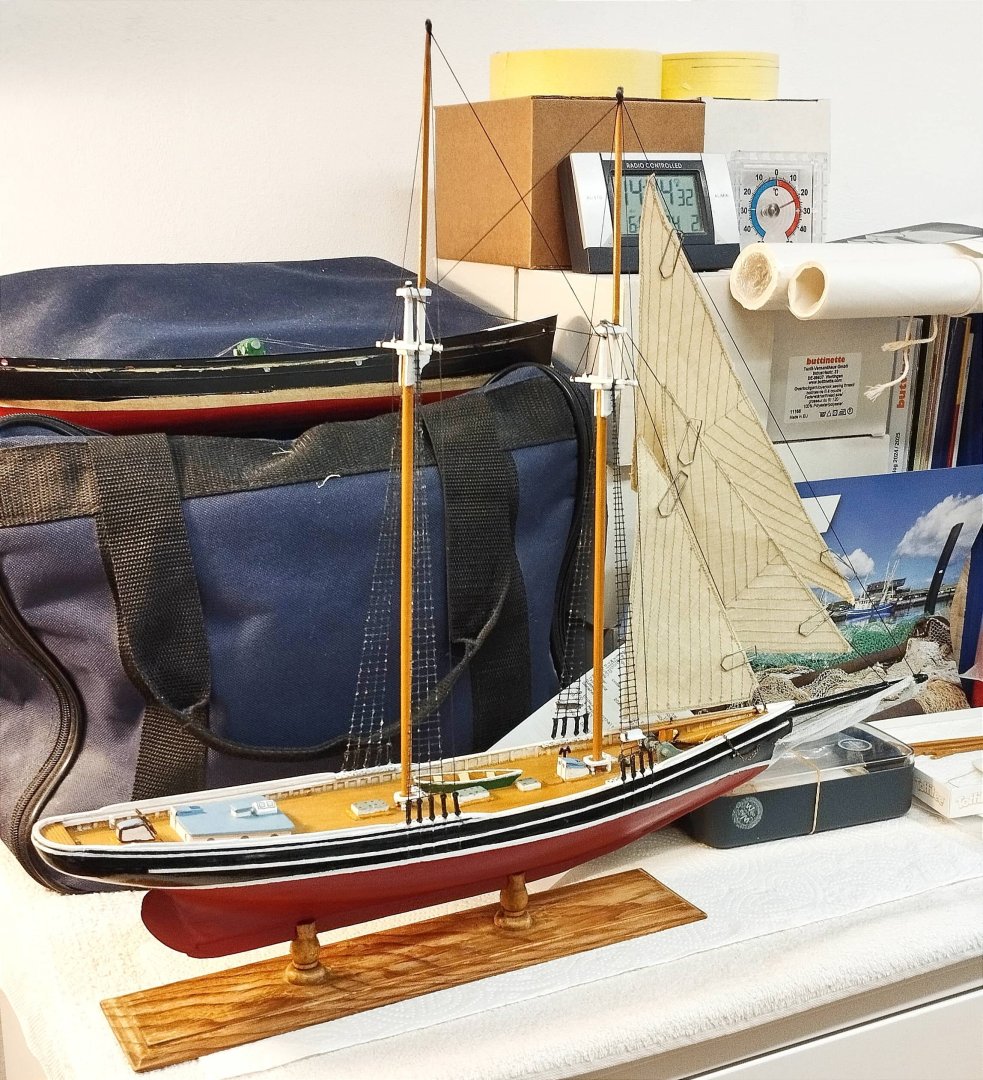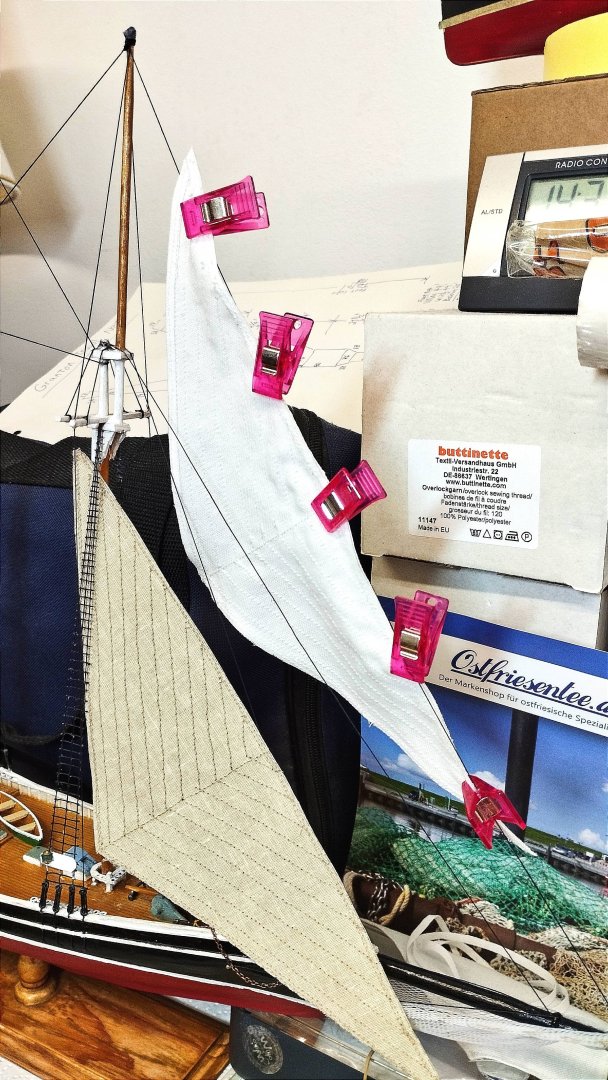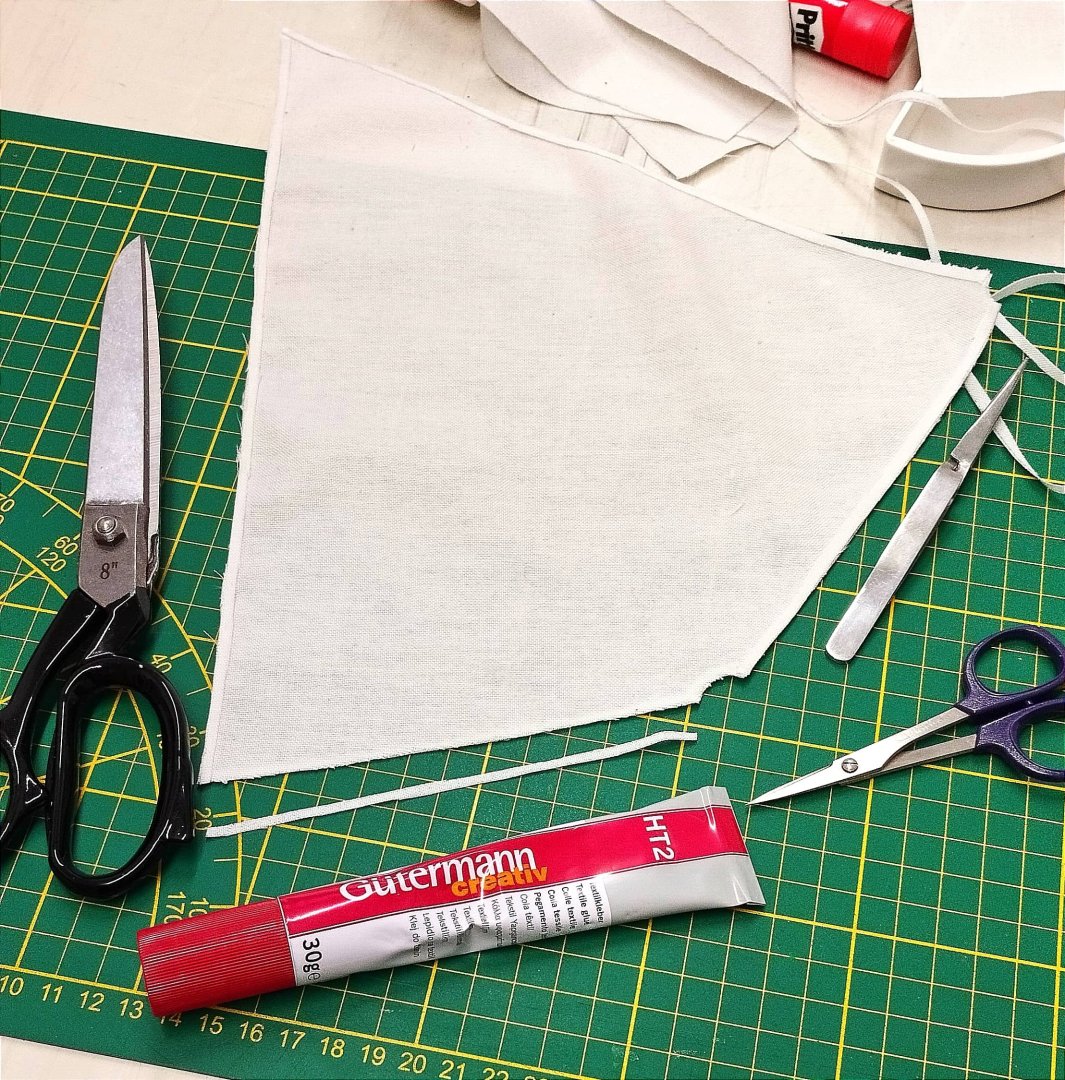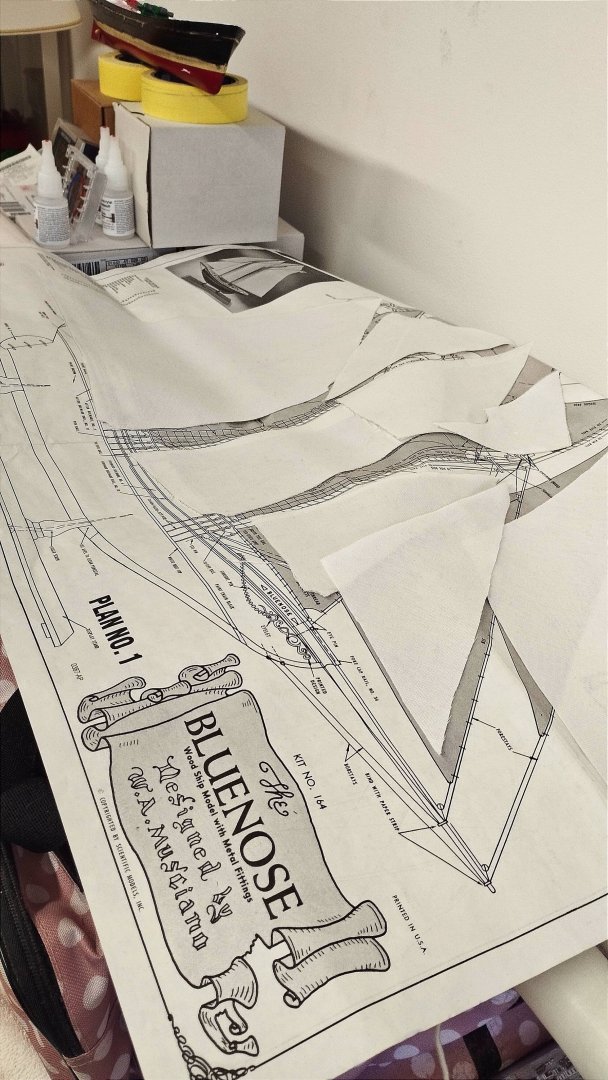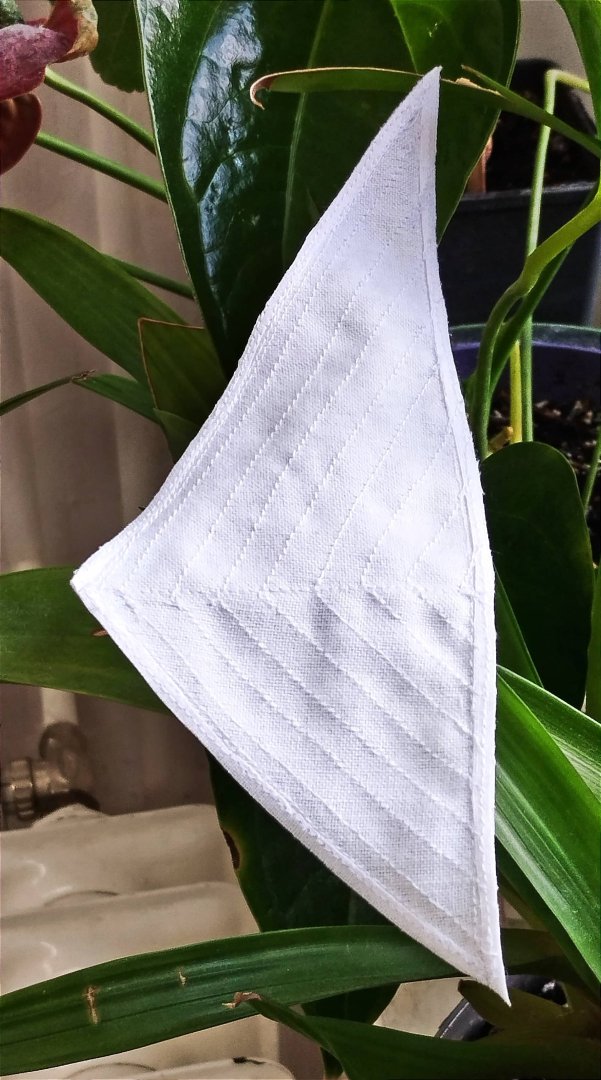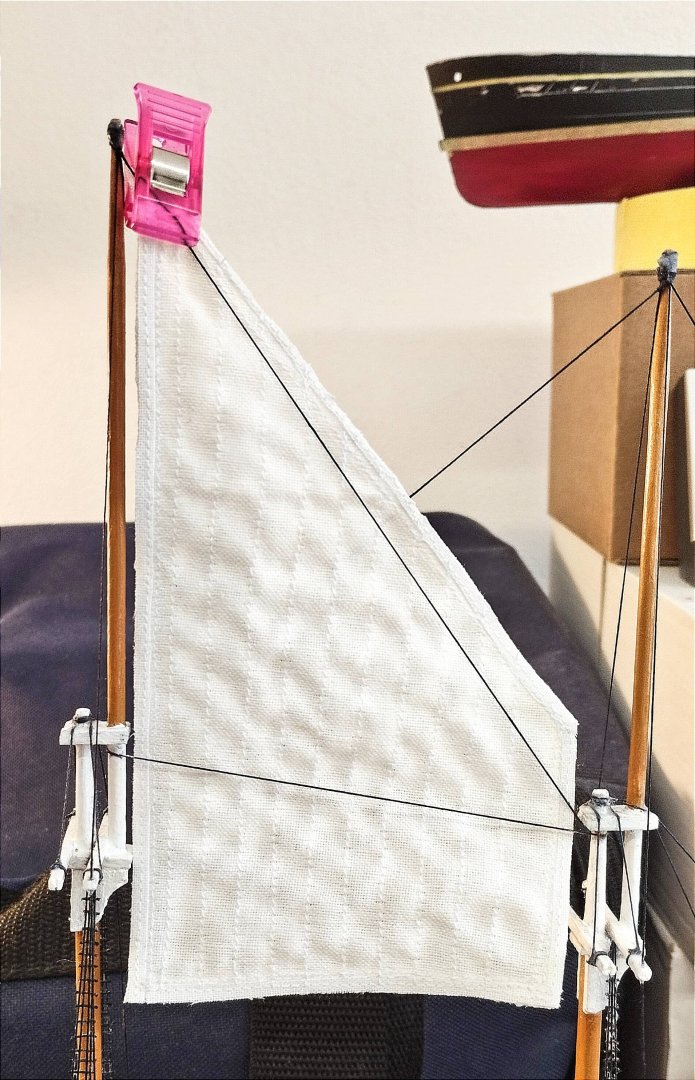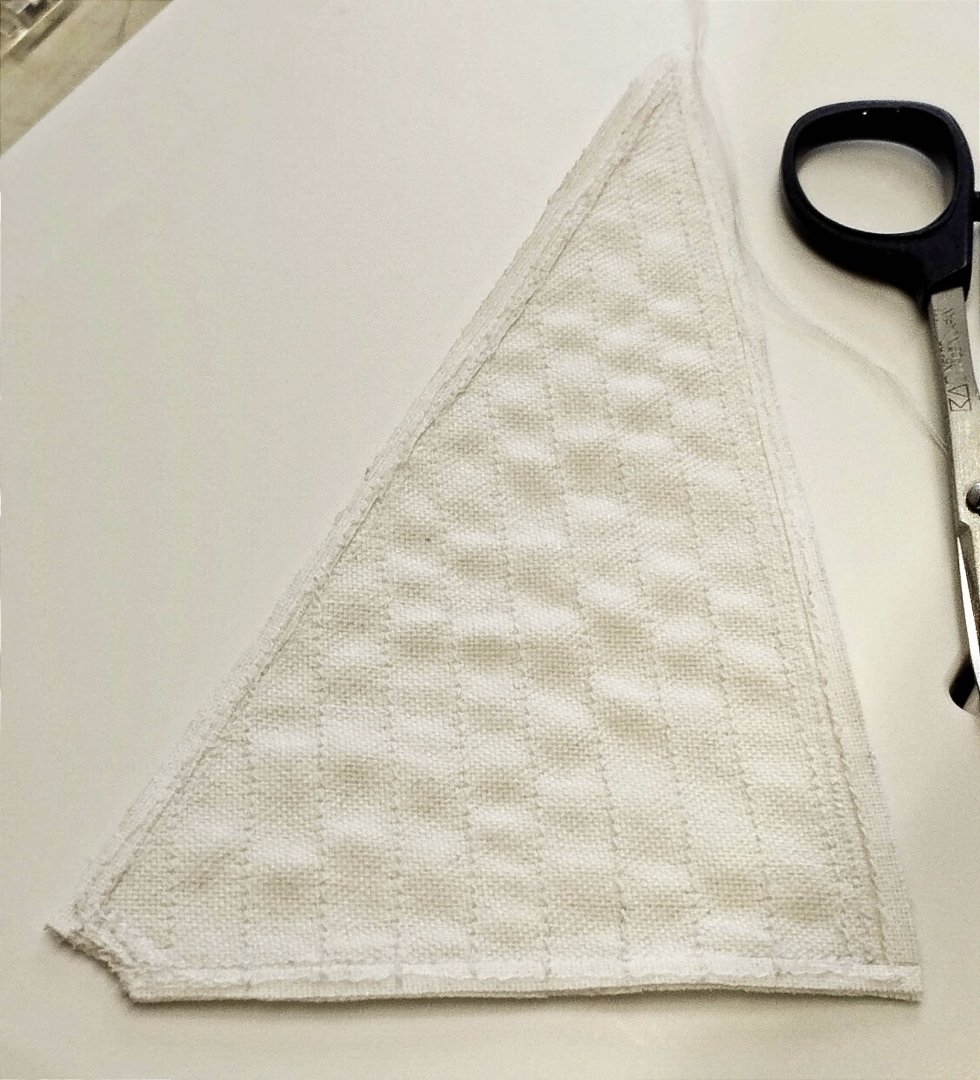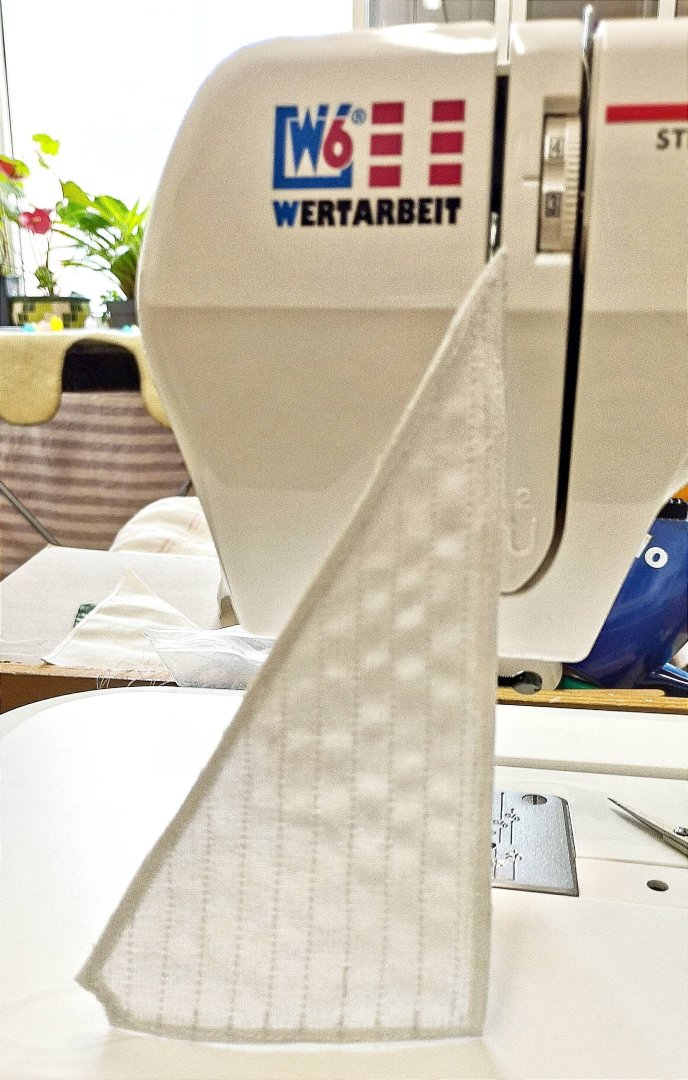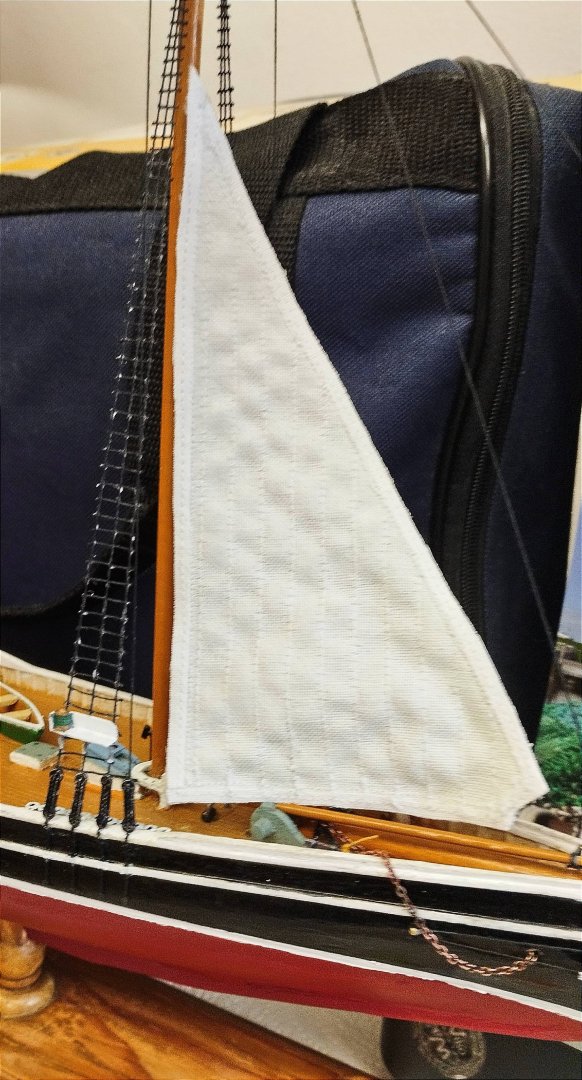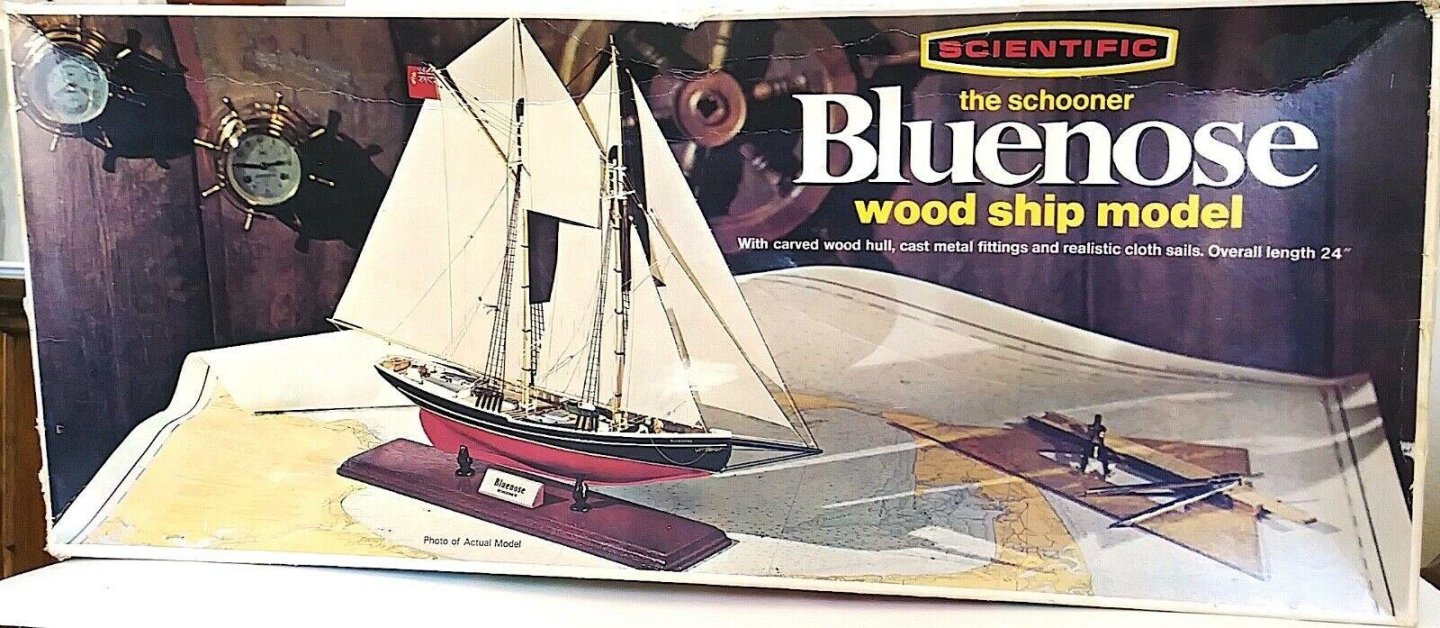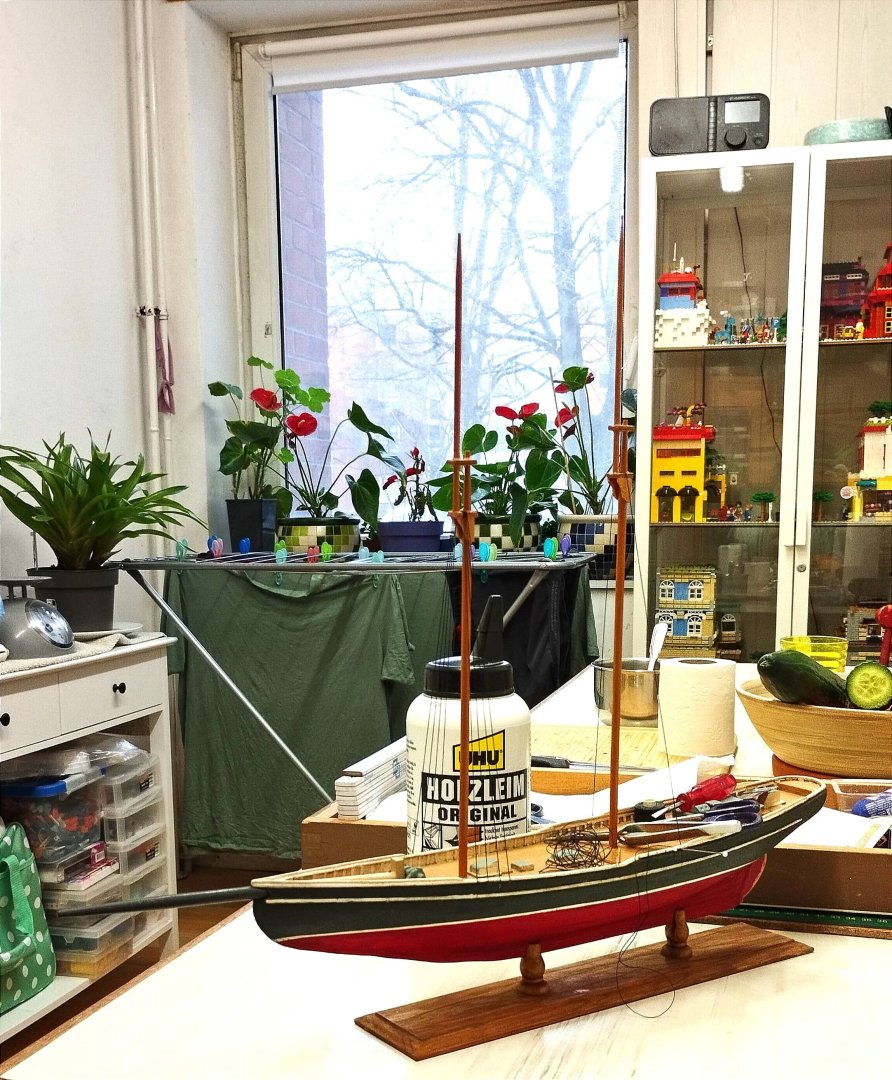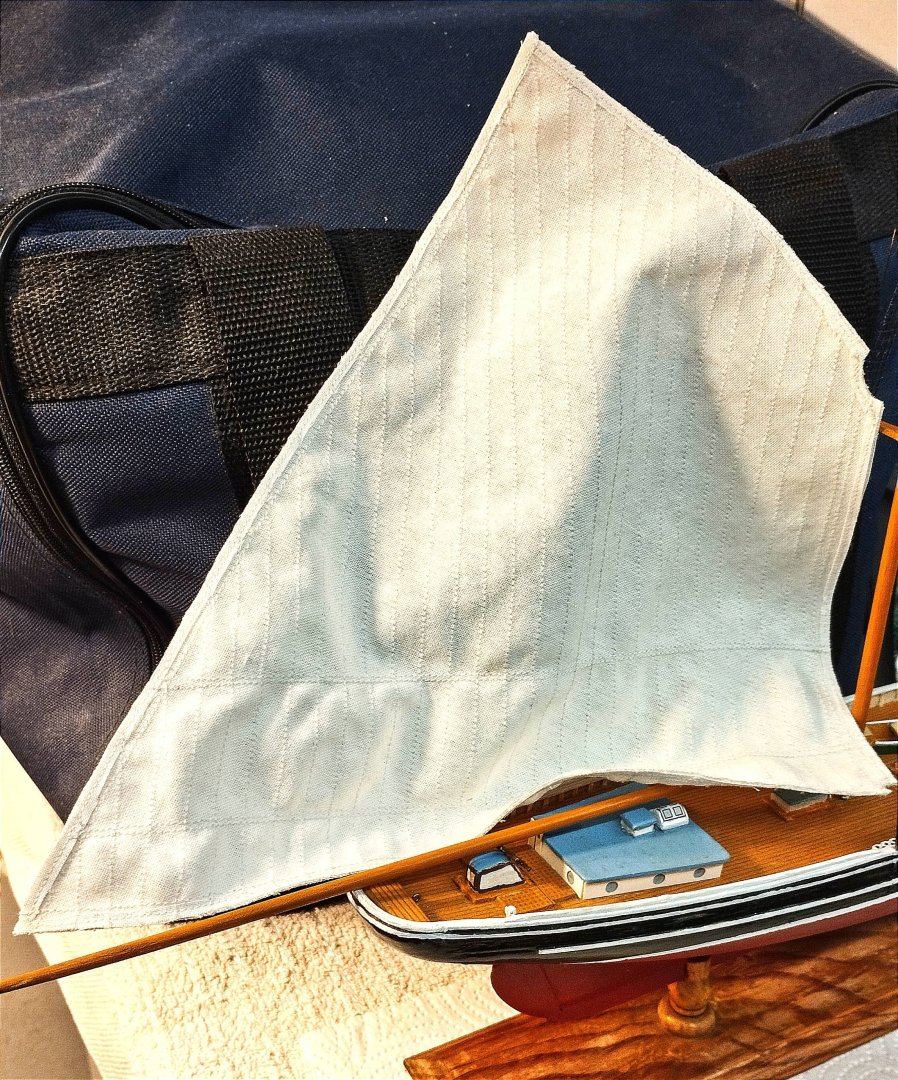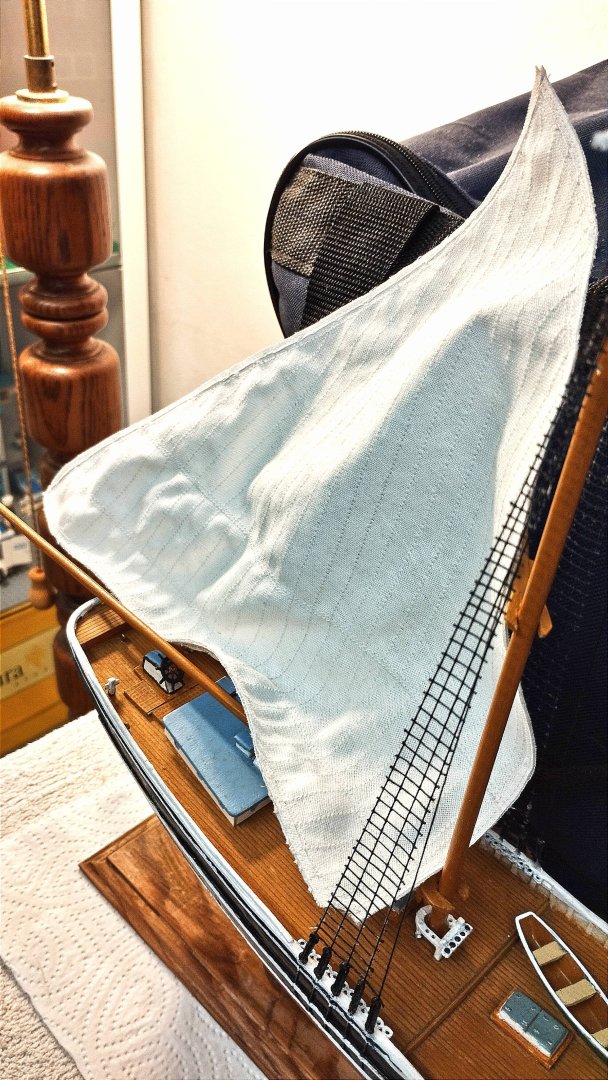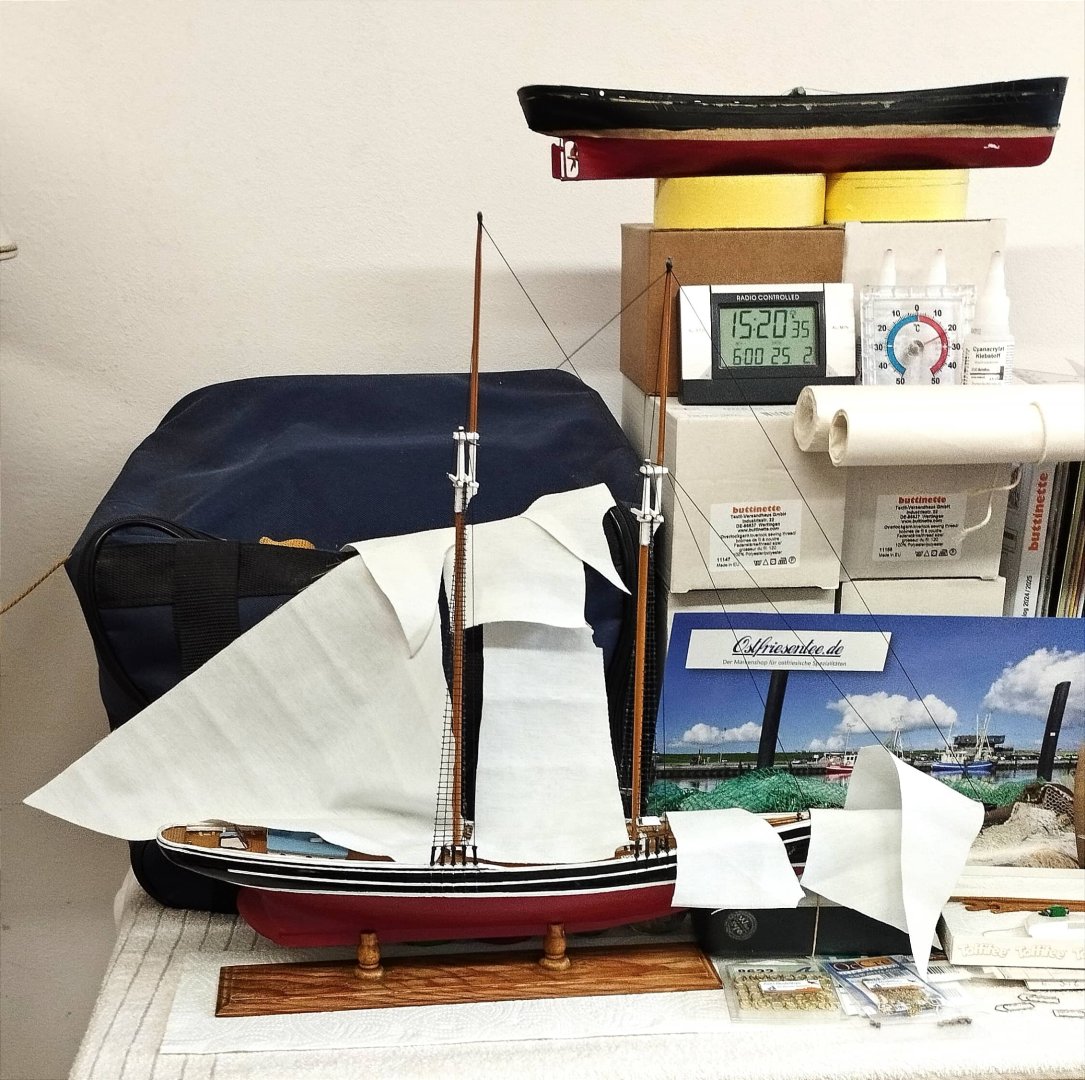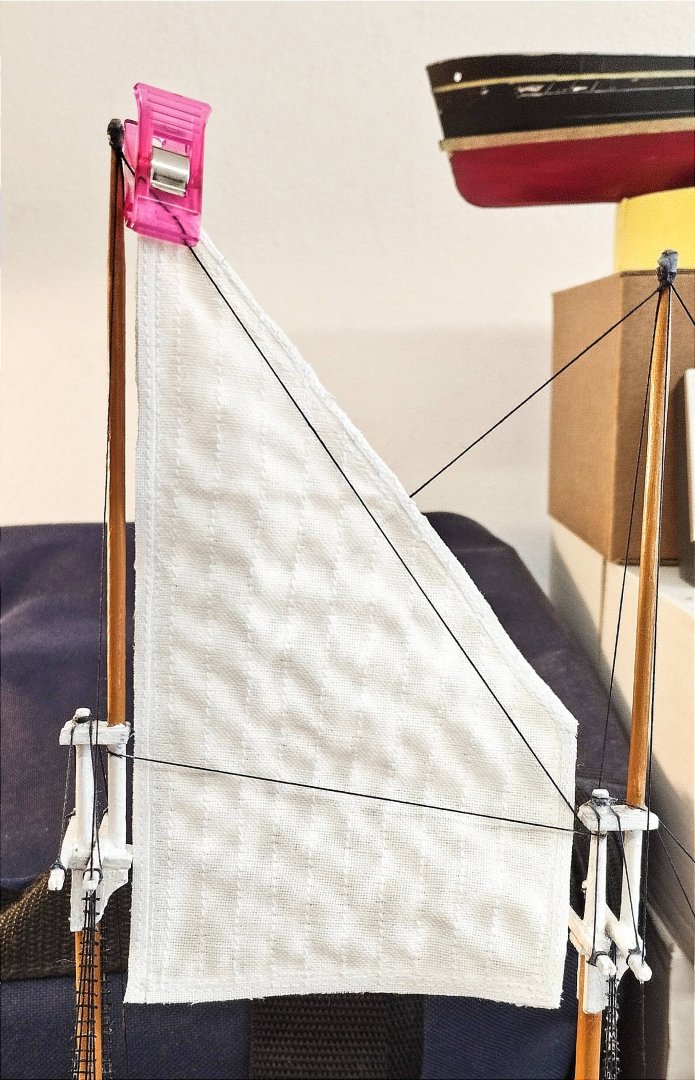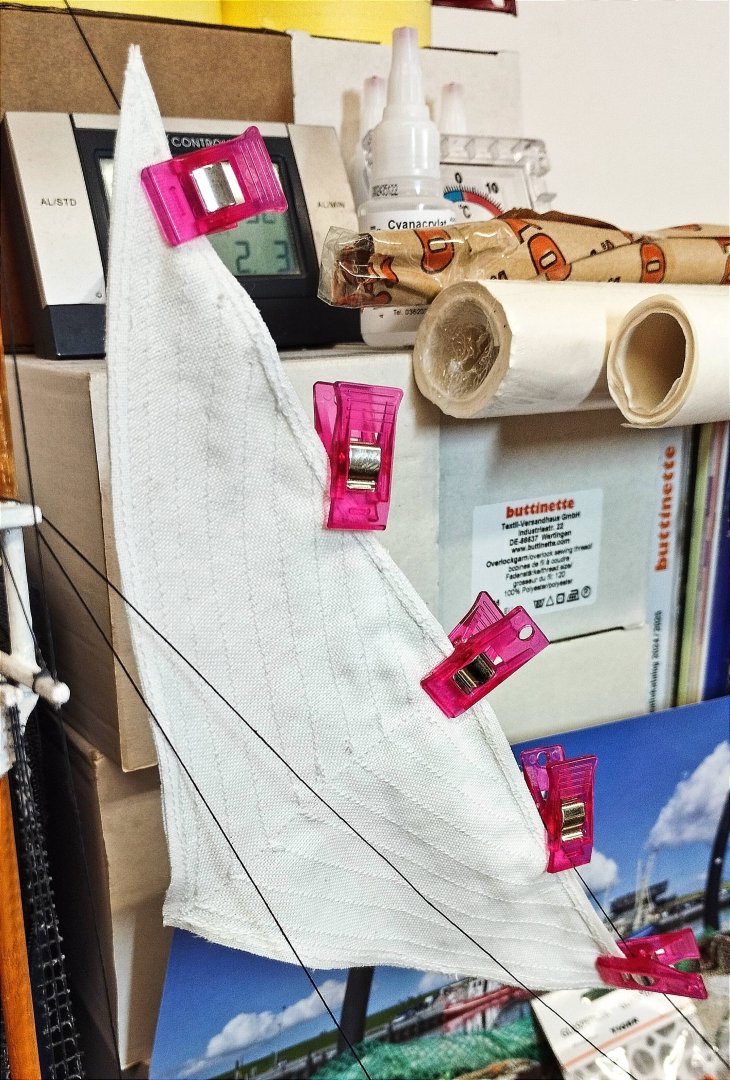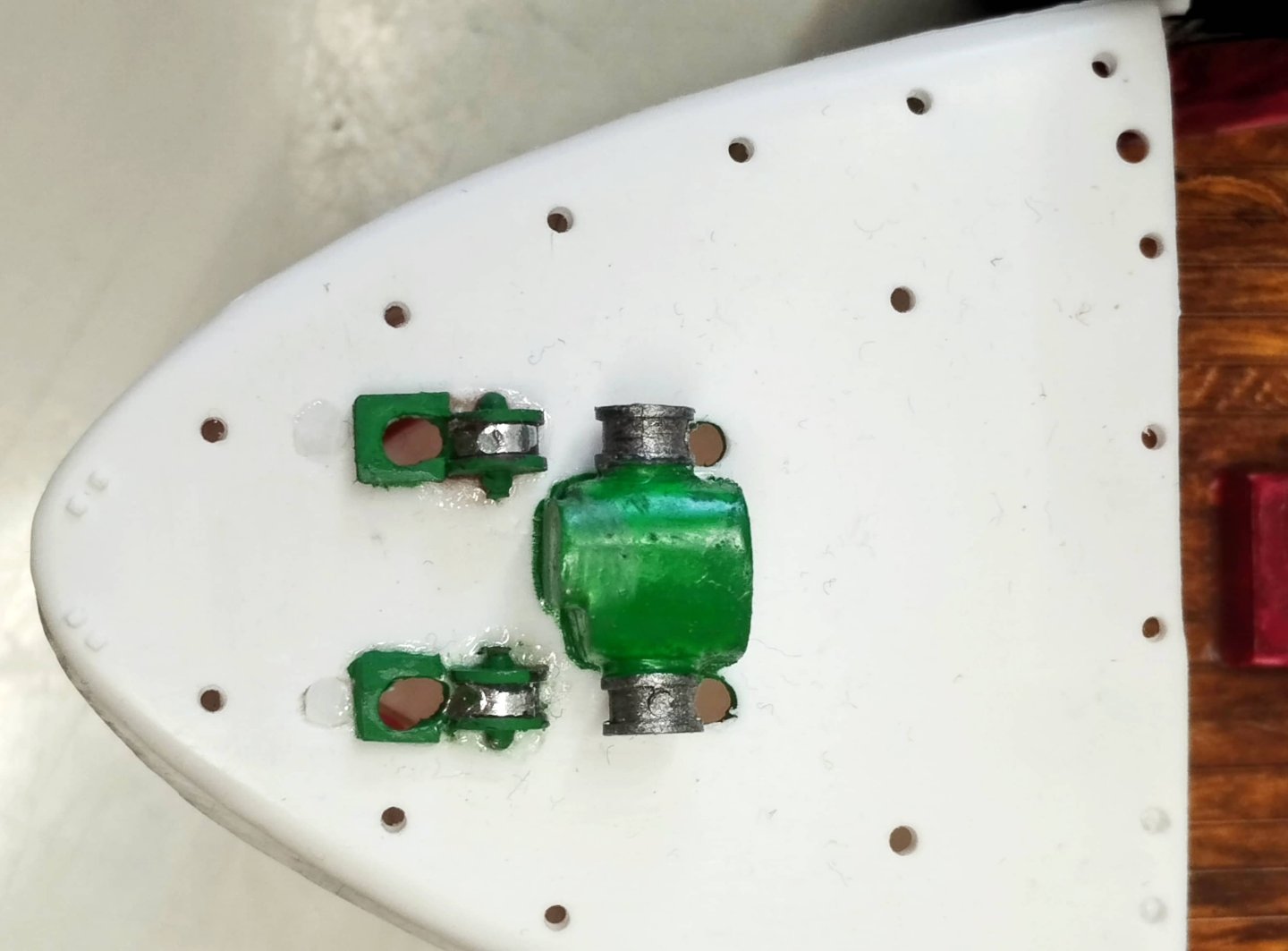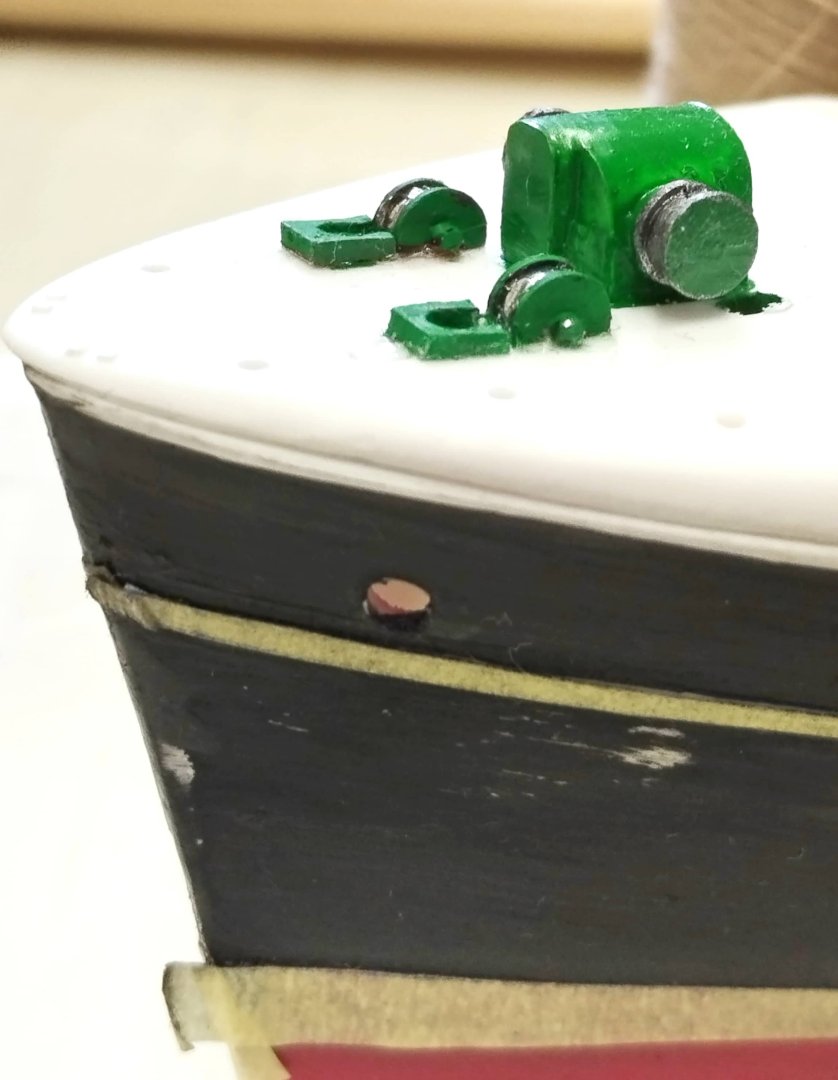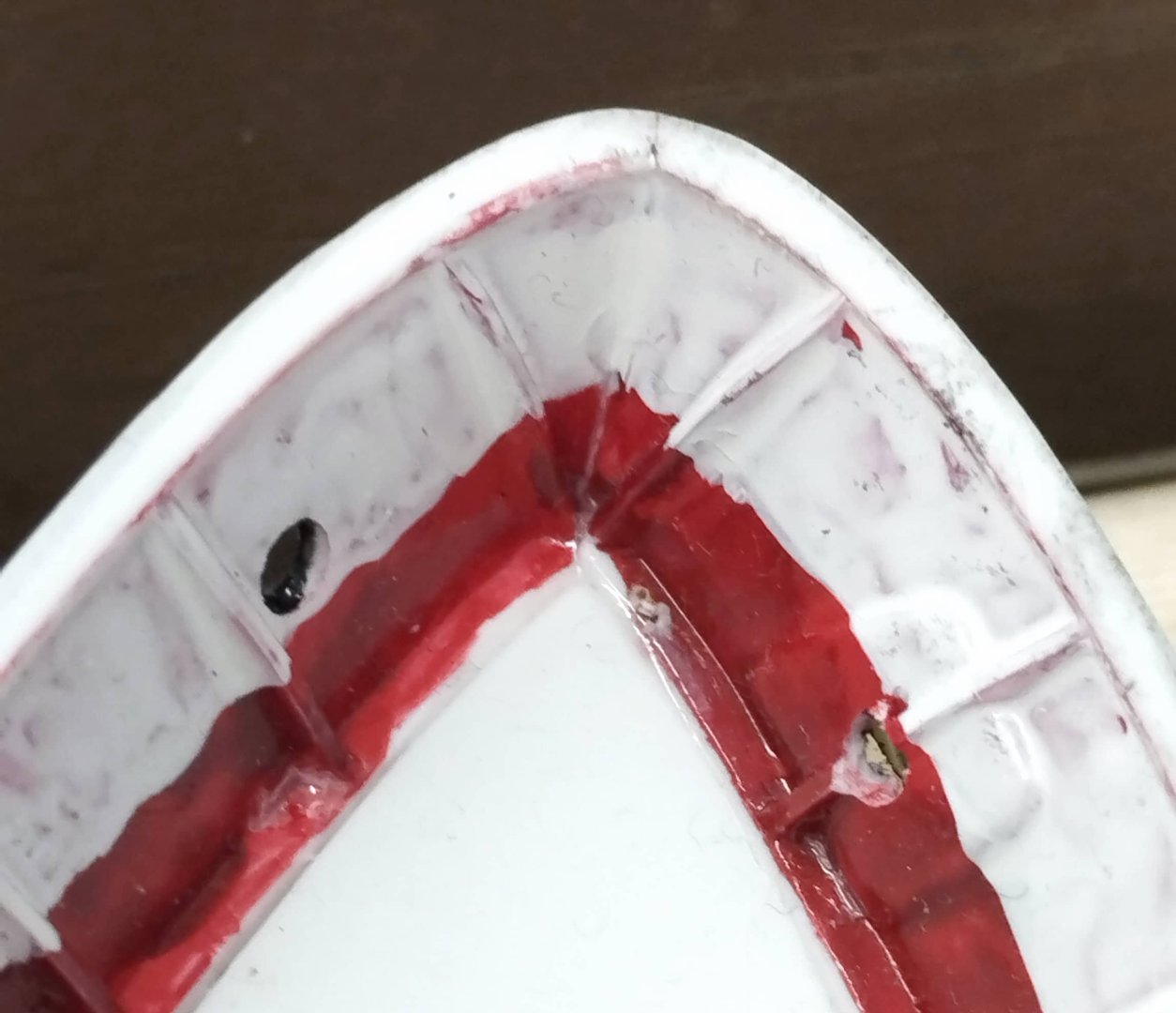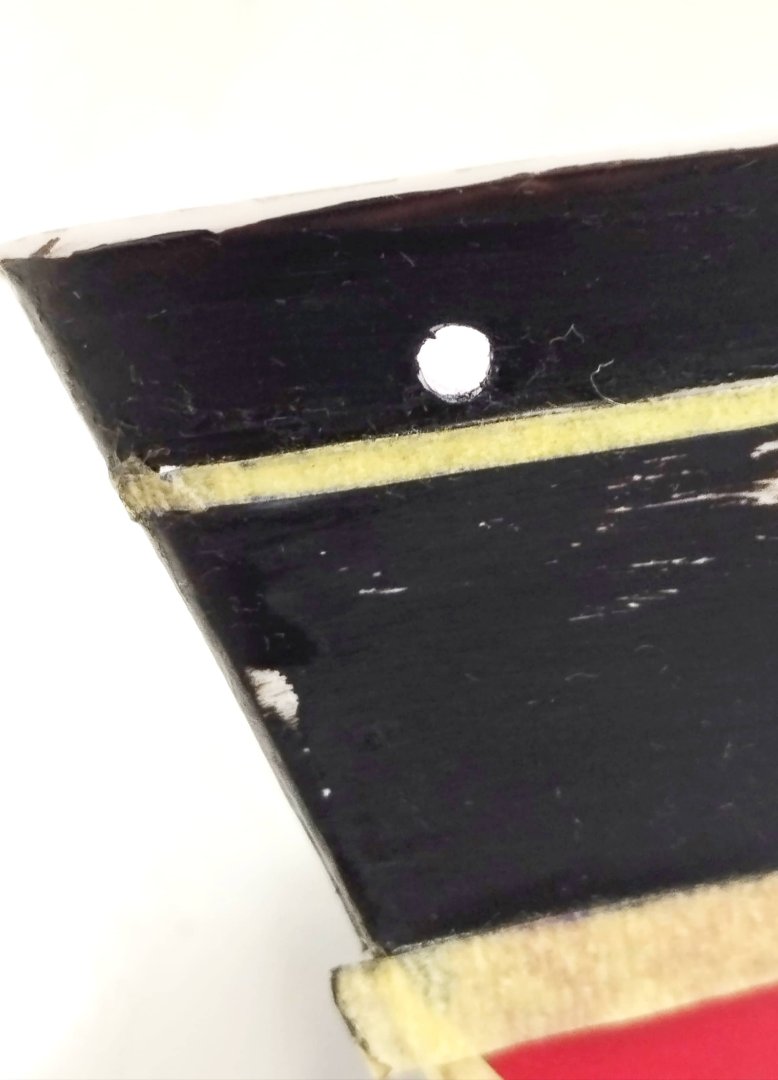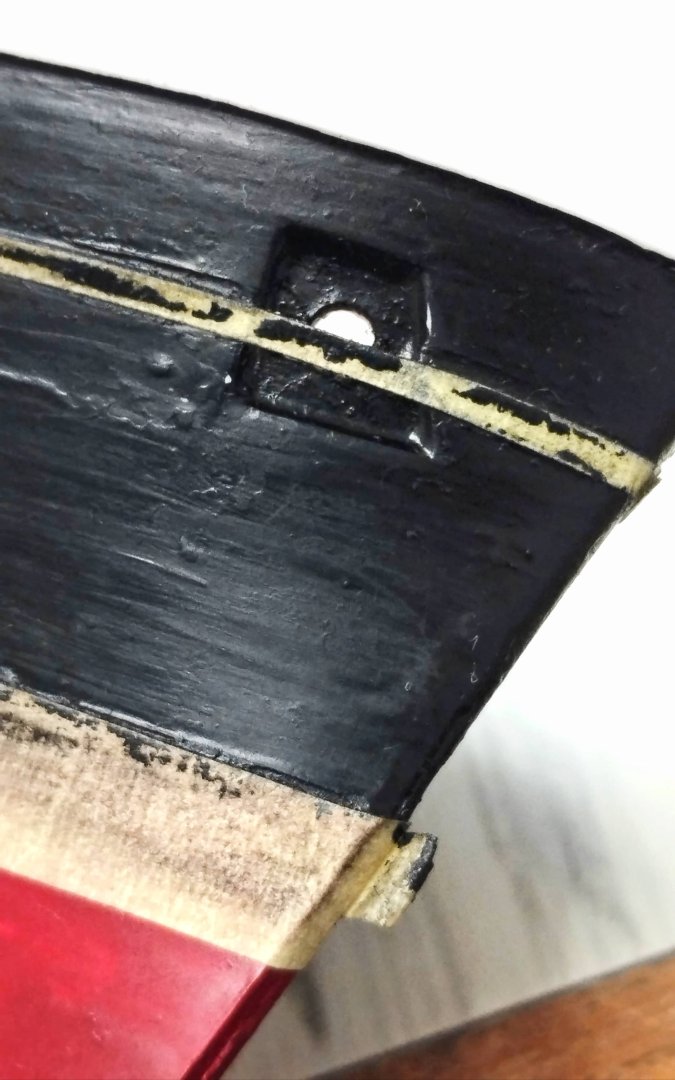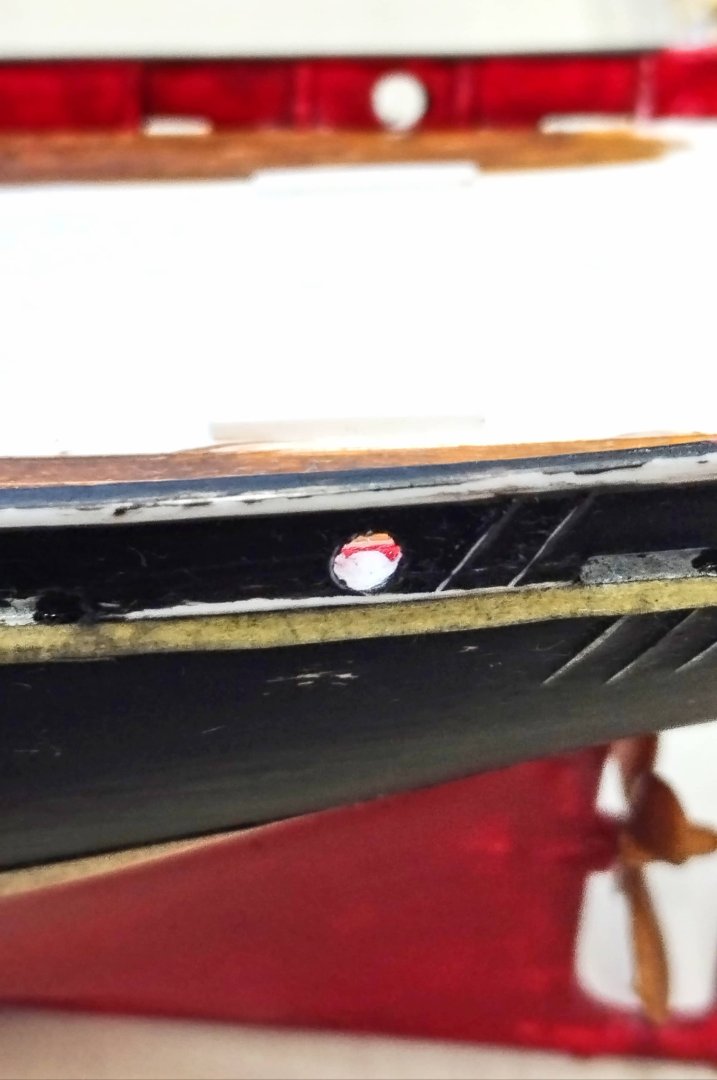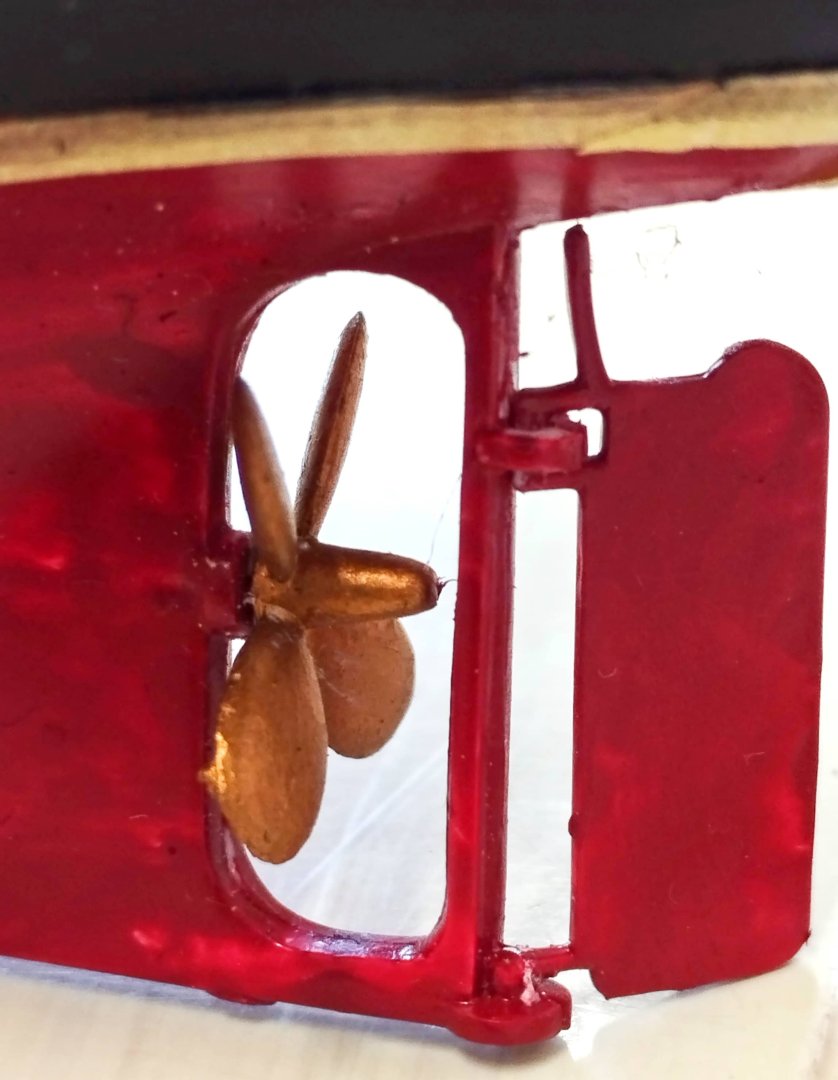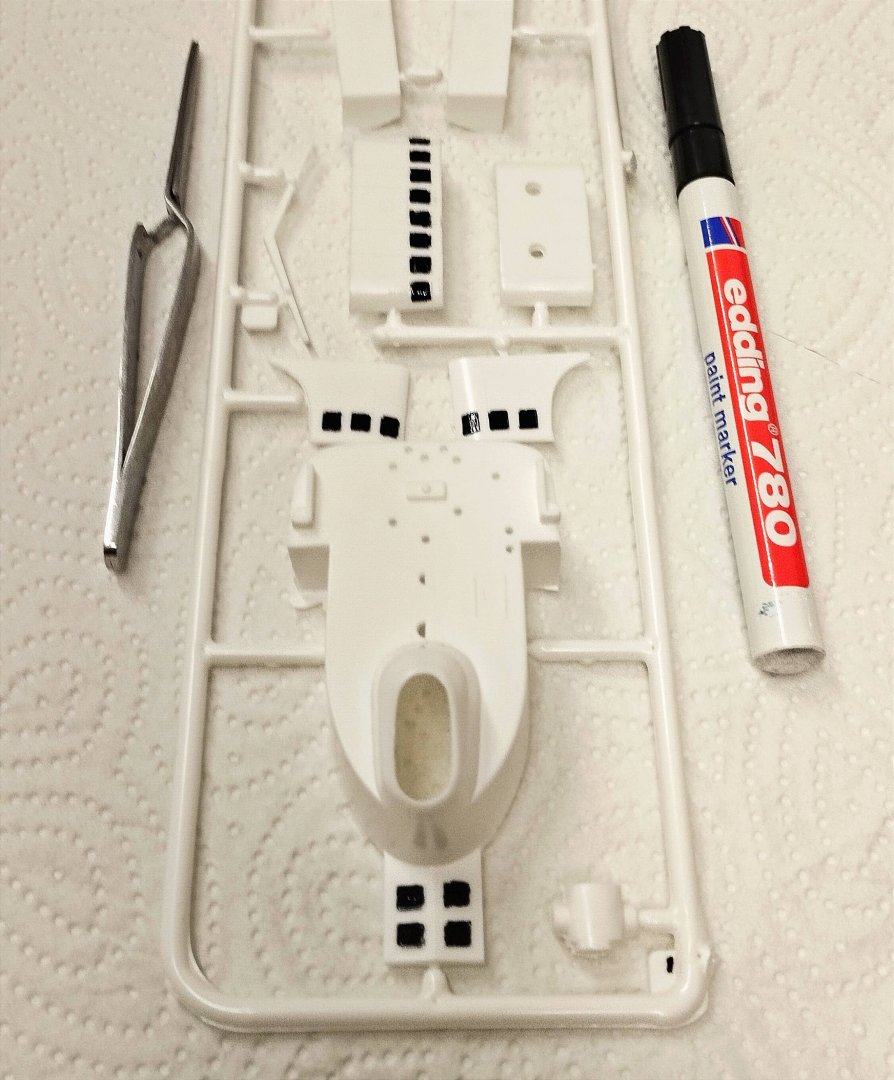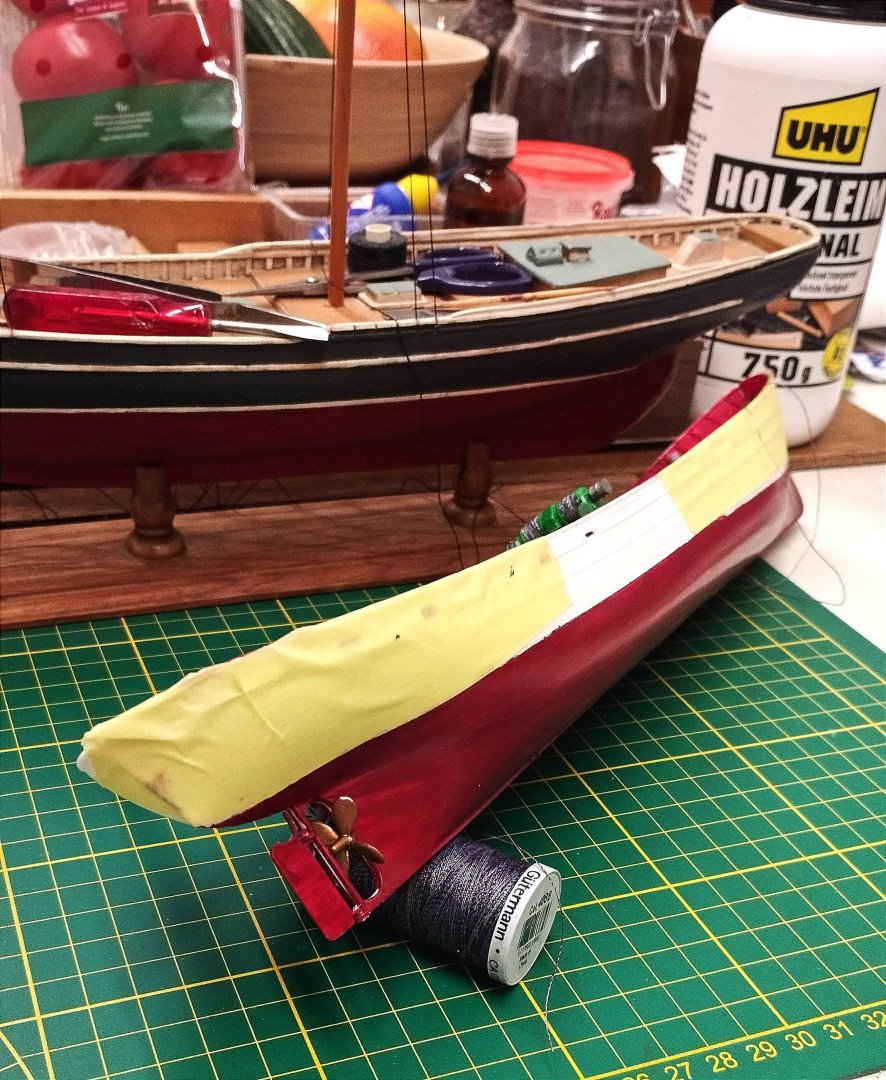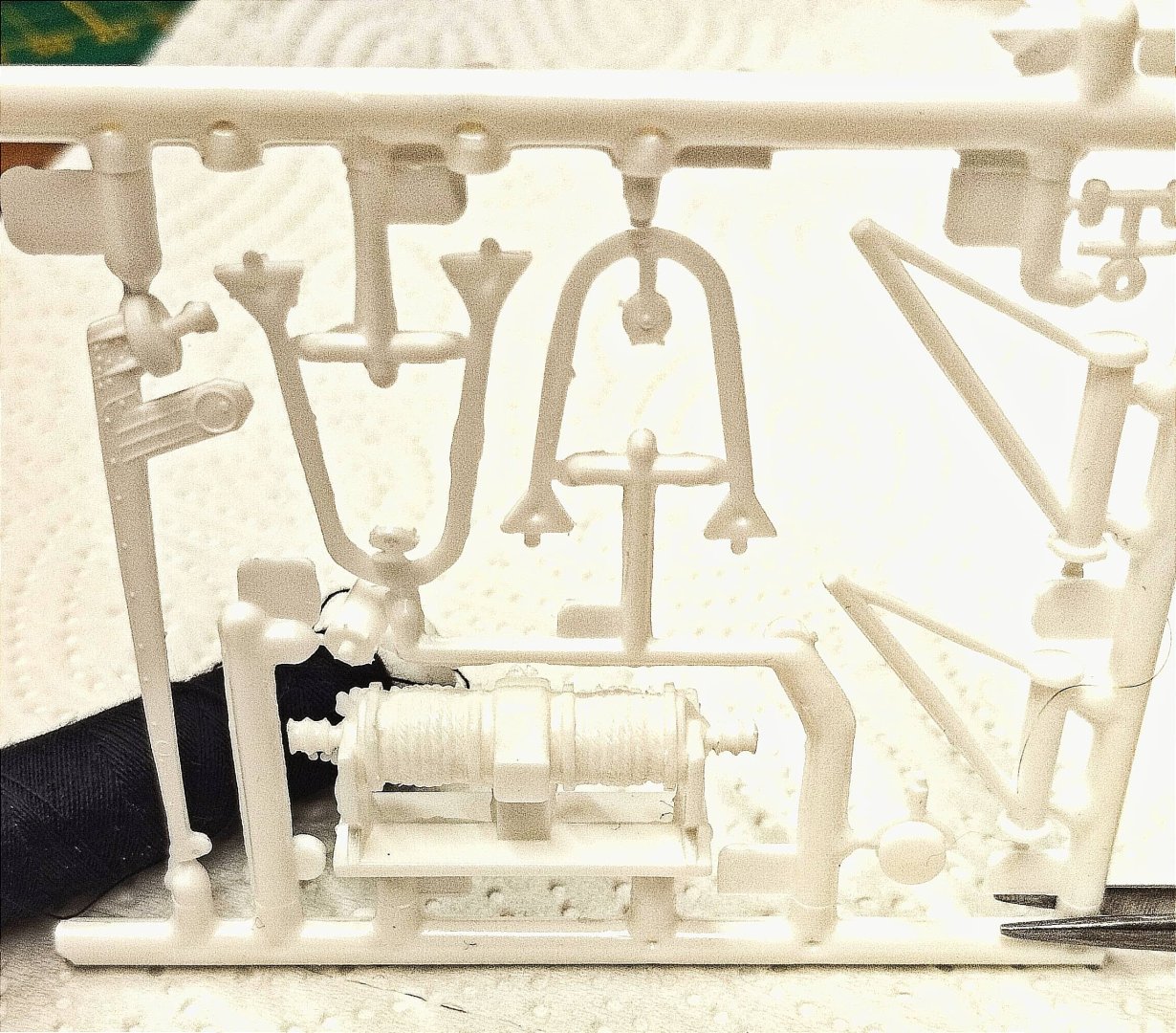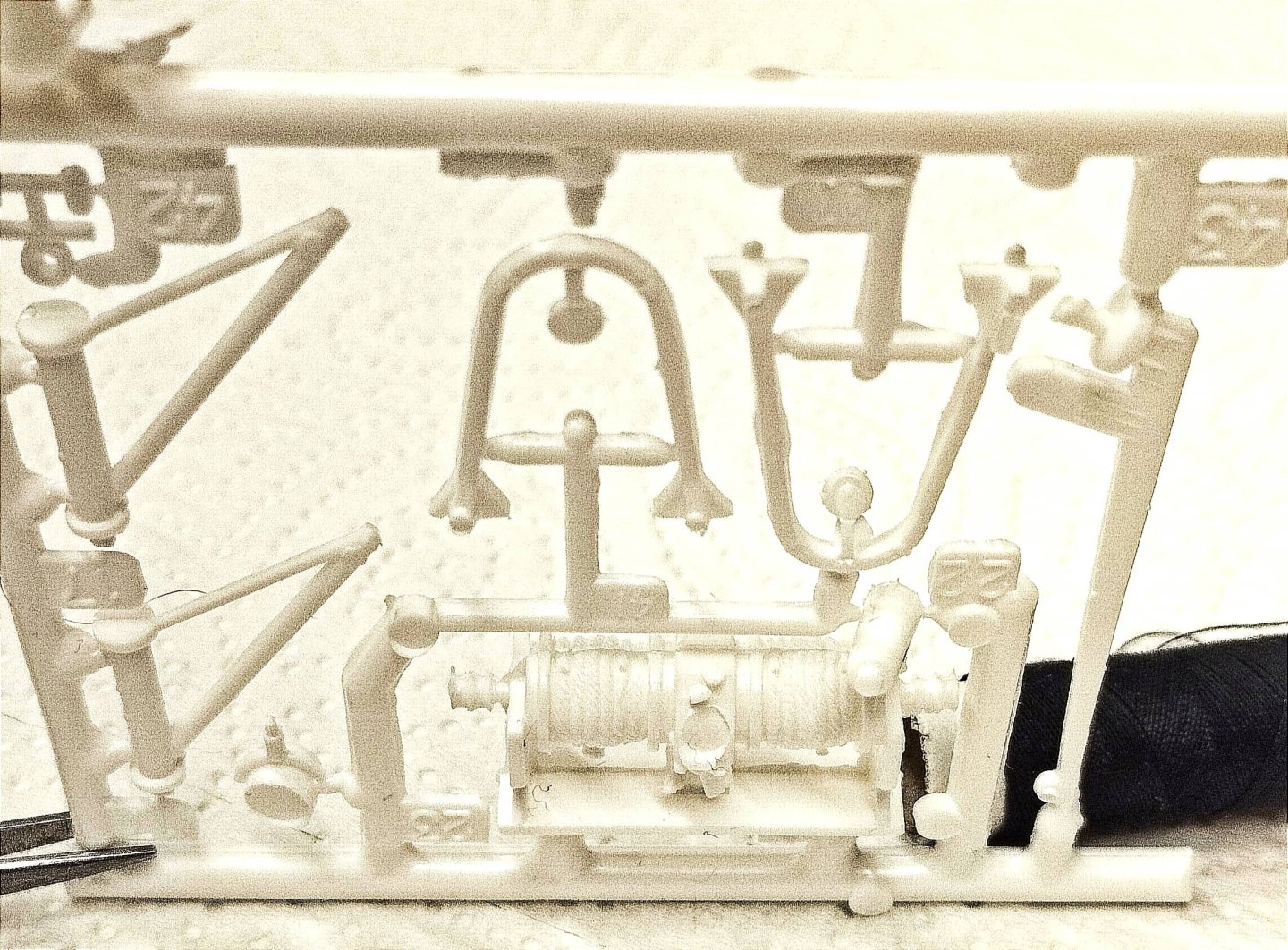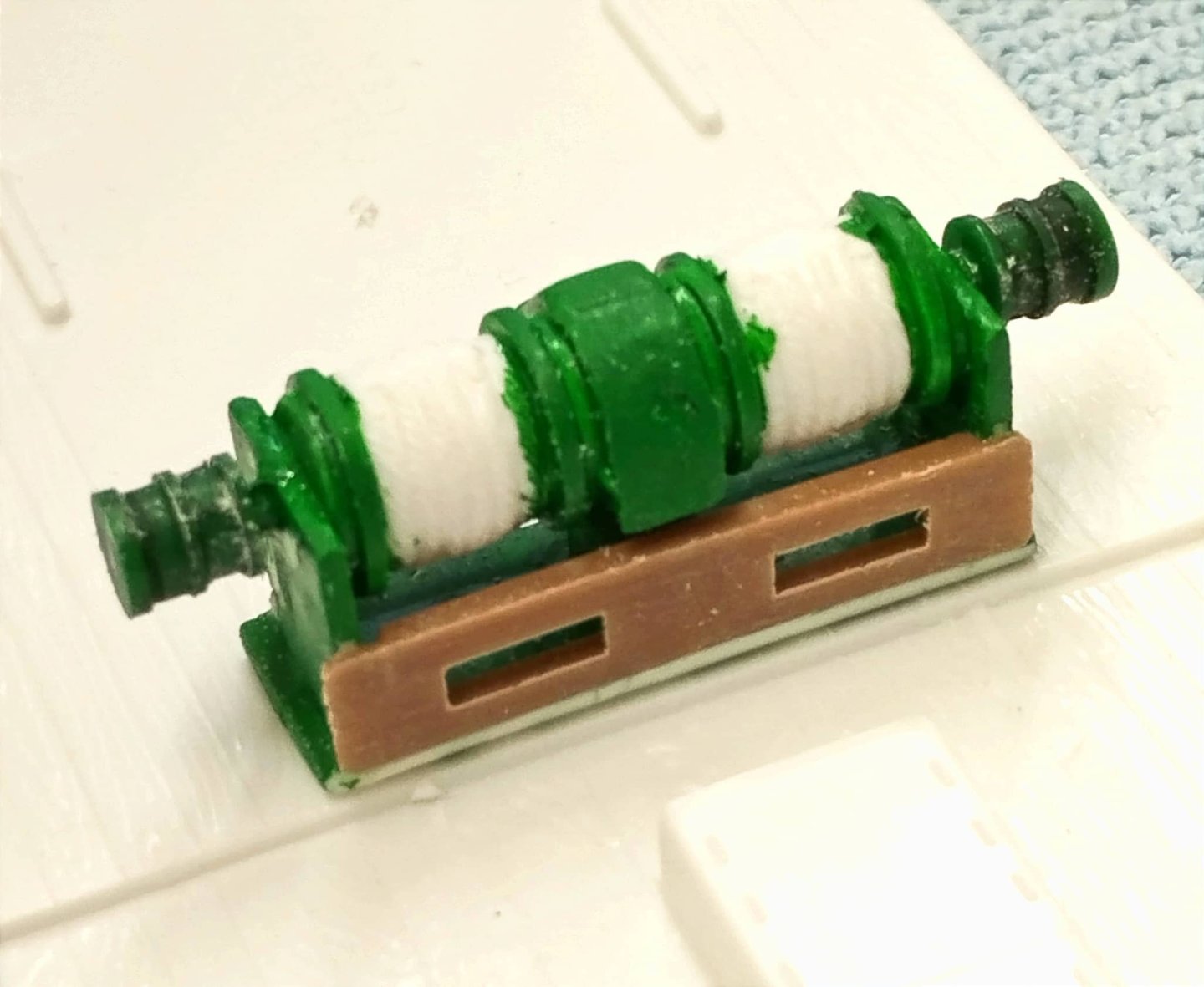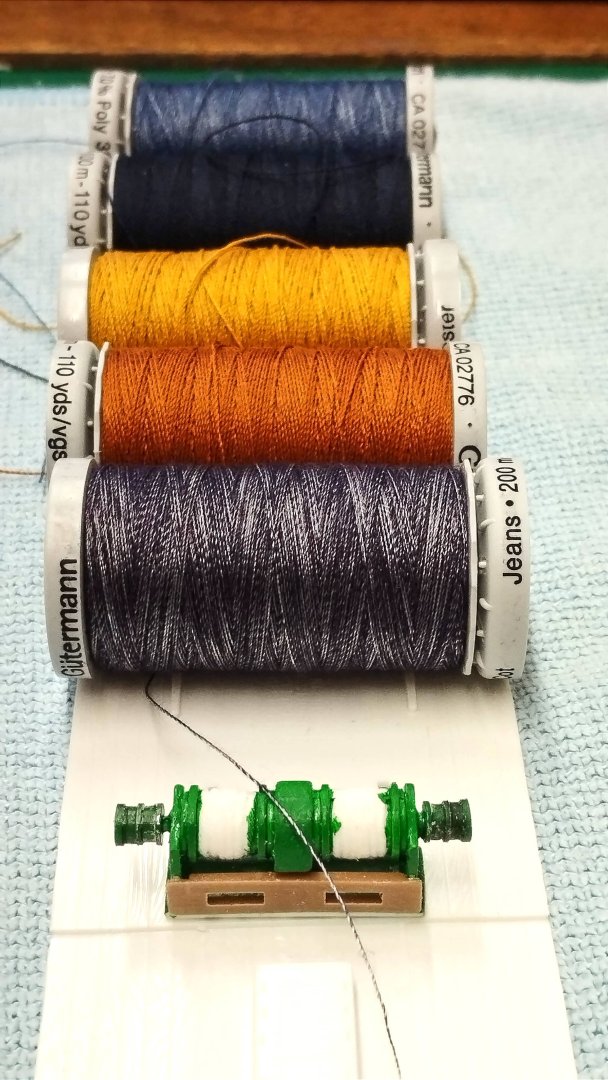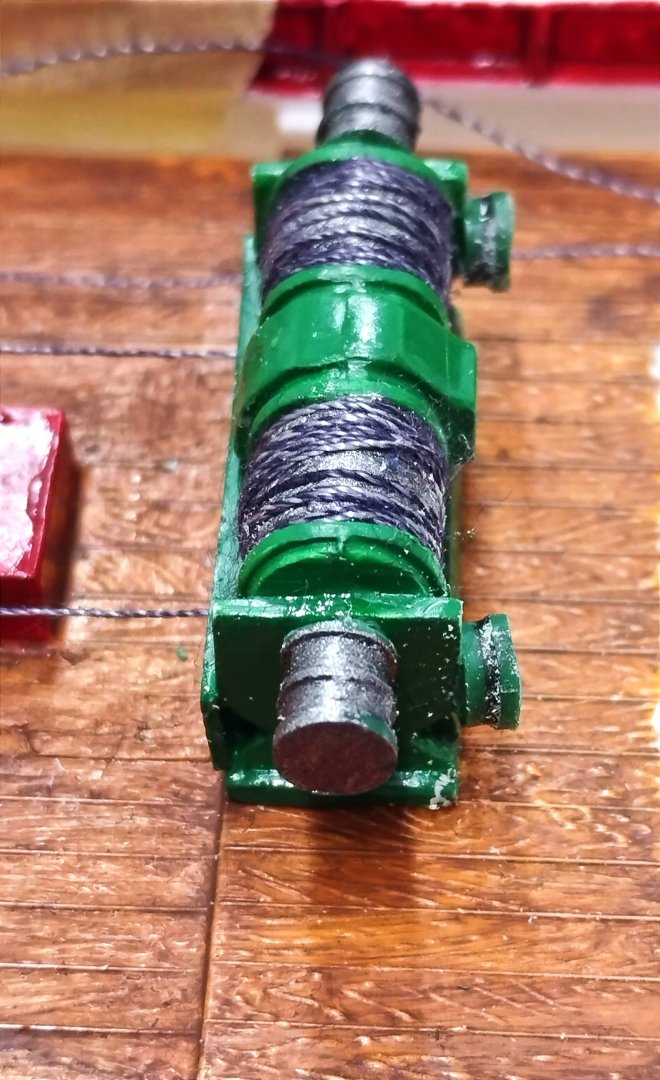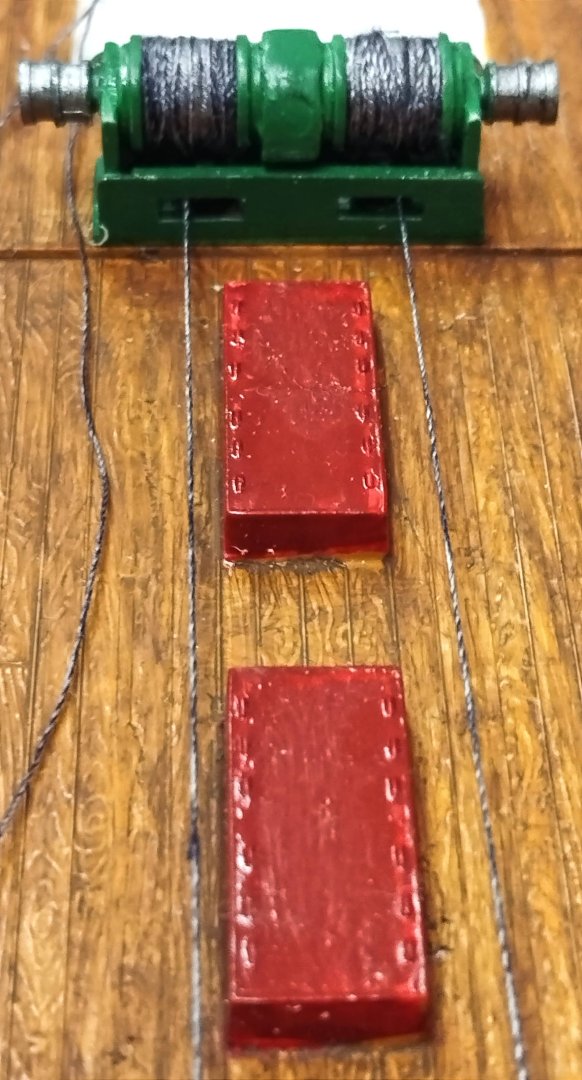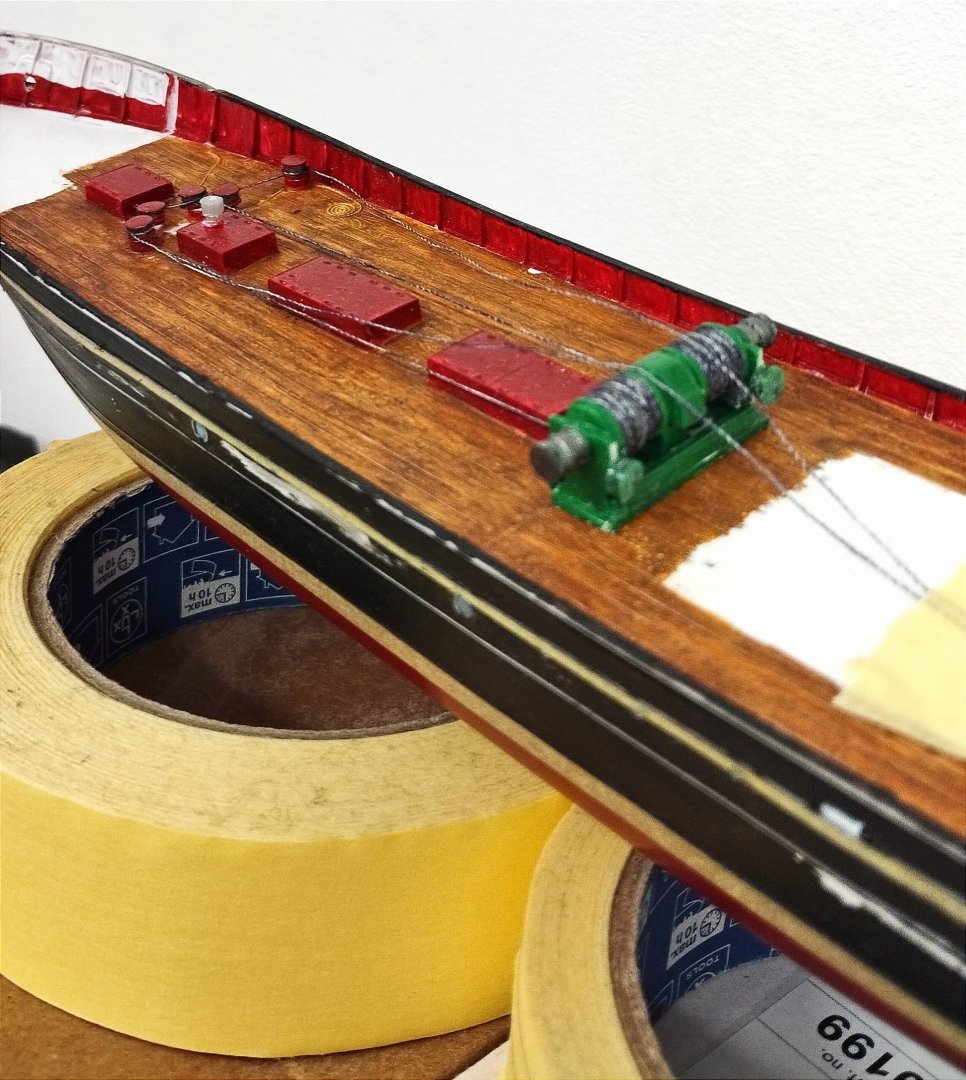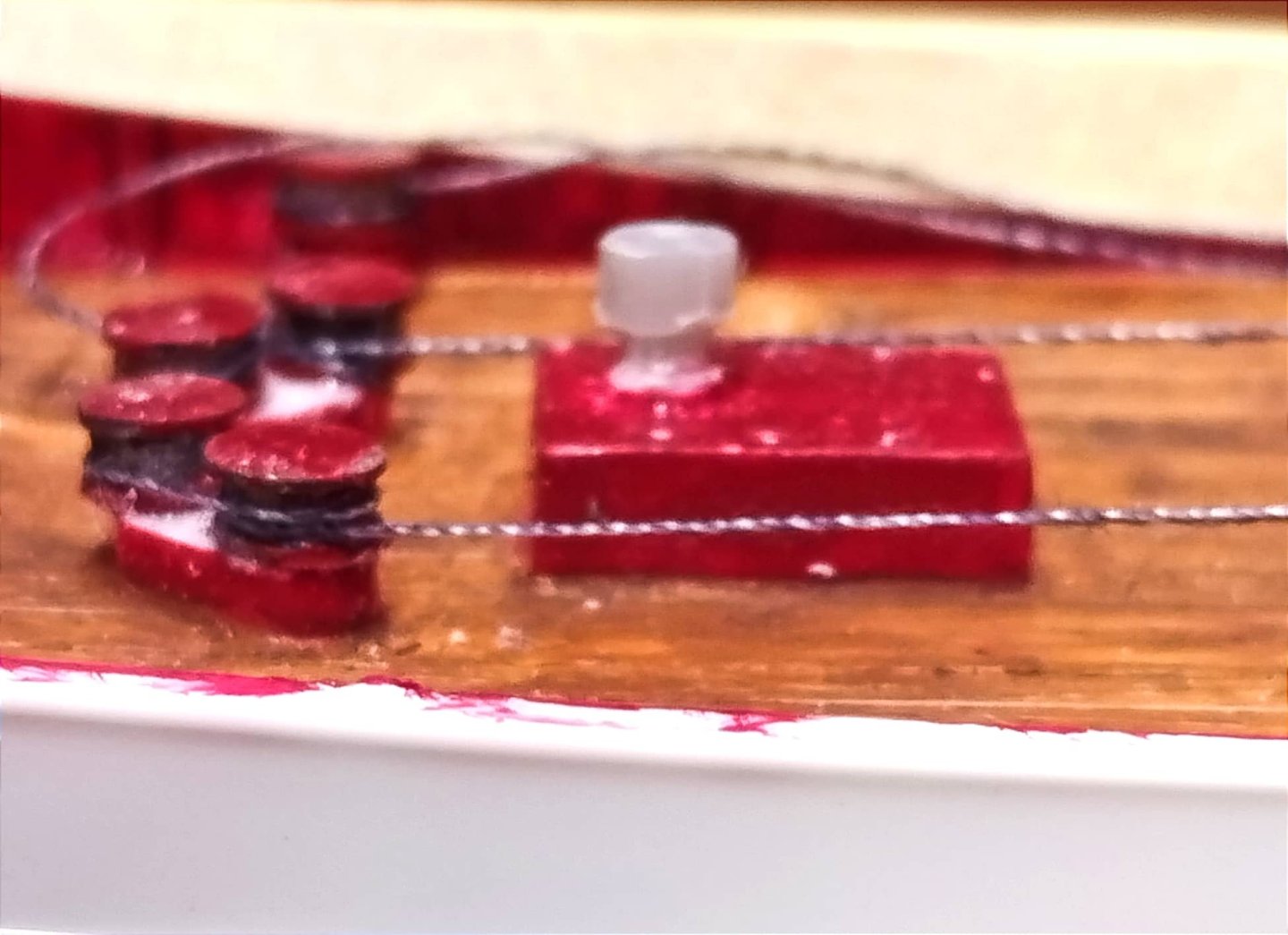-
Posts
43 -
Joined
-
Last visited
Content Type
Profiles
Forums
Gallery
Events
Everything posted by UrkVisser
-
Another modification: Now her Fisherman's Topsail can swing nicely to port and fill up with wind if the two sheets are loose enough. My shipyard is the dining room table. I moved these sheets to the eye-pins just aft if her main mast shrouds. Otherwise her main sail and boom would have had restricted side play. The plans with the kit were wrong and had them placed aft of her cabin. Peter Voogt from the Netherlands brought these things to my attention. Dankje Peter! 🇳🇱 Best Regards, UrkVisser
-
Ahoy! It's just after 22:10 here and I finally got through reworking my 'Main Topsail' and 'Fore Topsail'. They took two hours each! Alas I had sewn the gores into them vertical (Ooöops!) with a stitch length of 1 mm. It was indeed a miserable chore removing them all and as not to damage the Oxford fabric. Also my stitching around their boarders wasn't that great so I removed them all and resewed everything. Now they have their correct diagonal gore stitching and the interfacing on their boarders looks great! Tomorrow I will install them on my schooner as time permits. Good Night! 😴💤🌛✨☁️ UrkVisser ⛵
-
Sunday, 23. March 2025: Hi everybody! It's an enjoyable Sunday and I just installed the 'Fisherman's Topsail' on my schooner and did it's rigging while listing to my usual church service in Dutch. I also altered the schooner's 'Main Sail' and shortened it's boom which were both way out of proportion in both width and length. Old photos of 'Bluenose' (1921) confirm my schooner finally looks correct. Now everything above deck is in the scale of 1:76 whereas this sail and boom were stretched out to 1:72; check out the blueprint in the kit and you'll see what I mean! I still have to take maybe an inch off the 'Main Sail's' gaff in addition but only after I mount the sail to the mast and boom. The hull of course is 1:100 to fit using a 2 foot long 4" x 4" but this was the factory's decision (not mine). Maybe the size of the kit's carton was also an issue; who knows? About half way between 1:76 and 1:00 H0 (1:87) figures may look suitable; or maybe not? Best Regards, UrkVisser
-
Friday, 21. March, 2025: Moin! ☀️16° C. (Northern German greetings) I finally finished up installing the stay sail and both the jibs complete with the jib sheet rigging. I pulled this rigging tighter to her starboard side to let the jibs fill up with wind nicely. I'm really glad I decided to take the time to make this set of sails out of my old, white Oxford Broadcloth shirt! The impregnated sail material which came with the kit was as 'stiff as a plank' even after sewing all the gores into them. I saved all eight of them anyway to serve as sewing patterns incase I need to make spares. More on this later! Tschüss! ⛵ Best Regards, UrkVisser
-
Ahoy! I've been busy working on my trawler lately and fighting off the Flu. So now back to my schooner. I've now rigged my second sail the smaller jib. I poked the edge of the jib (which is very stable) with an awl and then hung it with seventeen 2 mm brass rings which was difficult. Then I installed four blocks and then rigged it in place. But there's still some rigging to do where 'Scientific's' blueprint is vague: It's the 'jib sheets' coming off the black stand rigging 'forestays' going back to either eye pins on the deck or to the fife rail. I don't know if this is to be on one side of the sail or on both sides of it. ...Hmmm?? ...Well maybe somebody can clear me up on this issue. I just got doing some alteration tailoring on my main jib and the fisherman's topsail so I'll be installing them next. I'm starting off the all the smaller sails. The Main Sail abaft is a puzzle in itself although my sail is very nice: 'Scientific' mixed three scales together when making this kit. (I actually wanted to avoid this topic entirely.) The hull itself is pretty close to 1:100 scale. Set some H0 'Preiser' figures on her deck and alas they look quite large. Then take into the consideration her two masts which calculate out to be 1:76 scale. But then calculate her LOA and the scale is 1:72. Baäah!!! And looking at 'Scientific's' blueprint and the mainsail boom one will notice that the boom and sail are much too long for the ship! If this is indeed really to be the 'Bluenose' (1921) then the end of the main boom shall only extend 6 cm beyond the taffrail. But it extends 10.5 cm with it's matching sail! If I decide to shorten the main boom and re-tailor her main sail then the LOA will drop to 1:76 and be in harmony with both masts. Then everything above deck will be 1:76 and from the deck down 1:100. This is definitely not the kit to buy if you like accuracy! One must also remember the fact 'Scientific' built mostly control line model airplane kits where scale was often manipulated so the model could actually fly. But back to ships! Maybe I will letter this model as some other fictive schooner and let things so be. Maybe she'll be called the 'Anna K.' or the 'Maria Louise' or something else. Best Regards, UrkVisser
-
Thanks John! Thanks so much for the photos! Regrettably this model doesn't have any scuppers ahead of the superstructure at all and very few behind or along side of it either. Therefore I need to drill them out and cut them to shape with a hobby knife without damaging her deck. The kit also has the quirk that the how the deck lays into the hull blocks the abaft scuppers somewhat. I wish 'Revell' would have re-tooled this kit; and I would have gladly paid double for it too! The 7 port holes on both sides may have also only been found on the 'Arctic Corsair' or another trawler. Best Wishes, UrkVisser
- 16 replies
-
Hi! Anyway, I wanted to have this doorway but still wanted the piece I cut out to remain perfect later for use as the door itself. This was very tedious and ticky work as I stuck the edge of an old single edged razor blade into this thick plastic bulkhead and then tapped it with a clock maker's hammer again and again, several times around, along it's rectangle cut out line until the piece finally fell out. But holding this plastic bulkhead with it shape and curve firmly against a block of wood clamped to the dining room table was the hardest part. There was no possible way to clamp this piece other than having the 'Admiralty' hold it for me really good. But it cut out nicely and only needed light filing or sanding. And I still have all 10 fingers and my wife too! 😁 Another very good reason for this door is also to give me access to thread my anchor chain on her starboard side and the mooring line on her port side. (The trawlers on Hessle Road in Hull and also in Grimsby always docked very closely moored together in a 'clump'.) And if my chain breaks (due to grandchildren or whatever) then it allows easy repair. So it's always good to think through every situation first! Best Regards, UrkVisser
- 16 replies
-
Sunday, 16. March, 2025 So after a lot of fine sanding and a couple coats of 'Vallejo Model Color' black paint plus various touch up work along the white line and painting the 7 portholes on each side grey blue to imitate the reflection of the sea or sky I may soon be ready to coat the upper half of the hull with 'Kreul Hobby Line' water based, clear acrylic satin varnish. Or maybe I will oder more 'Vallejo Model Color' this week and then repaint my white stripe matt white. I'm 65 years old and was definitely more 'sure handed' with fine detail painting last year. Another chore today was cutting the door into the ship's forecastle bulkhead. I painted the inside of the forecastle red one meter up from the deck and then white above like on the 'Ross Tiger'. I also need to buy or build a stairway with handrails for the port side leading up onto the forecastle deck. Next to it is also where the 'Tiger's' anchor is stowed. This ship only has an anchor chain hawse on her starboard side. On her port side is a fairlead for a mooring line. I have 1 mm anchor chain but need to make a suitable anchor as the one in the kit isn't useable. Her port side will get a looped mooring line out of heavy, green carpet thread. There is still various touch up work to do here next week. Best Regards, UrkVisser
- 16 replies
-
Today the weather was sunny and pleasant also when only 5° Celcius my 300 meter hike each way to my local home and garden center did me some good. They also have an art department where I bought a 60 ml jar of 'Kreul - Hobby Color' water based, clear acrylic satin varnish. It's made in Germany and can also be thinned. So I tested it out on a piece of discarded plastic sprue from the kit I'm building. I painted it with various patches of 'Vallejo - Model Color' black. After it dried, I experimented with my new acrylic varnish painting over the black with full strength varnish, half diluted with water and as only a thin wash. The one with full strength shines nicely but actually too much and was quite thick leading to brush marks even with my soft red wissel hair brush. The next test I did was with 50% varnish and 50% water was between satin and matt with no brush marks. But my test with only a thin wash was useless. Now I'll test 25% water / 75% varnish which should be perfect! I actually wanted to buy 'Vallejo 726519 acrylic varnish but only a certain model train dealer has it. Alas I just spent 53 € here and 53 € there for two orders of model ship stuff plus tools. So being retired I needed to avoid another big order this month. Best Regards, UrkVisser
-
Wednesday, 12. March 2025 Rigging My Ship: Hi everybody! I finally raised my first sail today which is the smaller Stay Sail. I'm using 'Krick No. 60860 3 mm blocks plus the rigging thread which came with the kit. I had problems getting this thick thread though one of my blocks but it was due to flat spots in rigging thread from the early 1980's. I solved the problem by running a needle back and forth through the block and enlarging it slightly by also pulling the eye of the needle through the hole in the block. Cutting the bad spot off the thread also helped. So it's on and looks good! Here's also a photo of the ship's cabin which was originally only a stack of slivery balsa wood. I cut white carton off of a medication box and then made port holes in it with a rotary fabric punch pliers. The greyish sky blue reflection in the windows happened to be a piece of a cash register slip which was the right color as a signal the roll was coming to it's end. One spoke on her ship's wheel broke off so I replaced it with the tip of a toothpick after a lot of 'micro-sanding'. H0 scale maritime figures should look good on this ship. But finding a either a suitable trawler or freighter crew will be a task. And the bow sprit net on her bow was made from the net which garlic was sold in. You sure wouldn't get me oit there without one! Best Regards, UrkVisser
-
Hi everybody! Today I finally installed my first 3 mm block for rigging my ship! Putting 2 mm brass rings on my Stay Sail was a chore (15 in all); alas two flew away 'into Cosmos' or where ever. These really fit tight and 3 mm rings would have been better but I have a lot of these 2 mm rings to use up. I finally got the sail hung on my ship and then glanced over at the blueprints: "Gosh! Noöoo!" I forgot this sail also needs to get sail tie downs and thus 2 horizontal rows of stitches: one row above the tie downs and one below (like what I also did om my Fore and Main Sails). So I had to clear away my end of the dining room table from all my ship building stuff, get out the sewing machine again and only for a 5 minute job. Baäaäah! I also had to getting cooking straight away as my wife wanted a nice chicken dinner and she comes home from work as hungry as a bear! That limited further progress for today. The Stay Sail is not yet attached. Tomorrow I'll hang and rig the Stay Sail. Good Night! 😴🌛✨☁️ UrkVisser
-
Sail Making Power Tools: The Sewing Machine! A good sewing machine doesn't have to be expensive. My machine only costed me 100 € new and was made in Taiwan by the same factory who also produces machines from 80 € to 8000 € (and more) for various other companies. Something important to look for is a machine with various interchangable feet as you also wouldn't use a Philips screw driver on a slotted screw would you? I like fully mechanical machines the best and really you only need one with 'straight stitch' and 'zig zag'; but an important feature is a 'stitch width' control! Left = Length / Right = Width Of course you won't be zig zagging your sails but in the 'straight stitch' mode the 'stitch width' controls shifts the position of the needle to the left or to the right as need be. I set my needle to a desired position from the left side of my foot using a small ruler. Then I only watch the leading edge of the foot and not the needle. This is a big help in sewing the gores on a sail! Set the needle say 1/4" away from the left edge and you will sew perfectly straight every time by only watching the left, leading edge of the foot running a long the edge of the cloth or the last gore you sewed. The next gore will then be perfectly straight and 1/4" away from the last one. No pencil marks or marks of any kind! Here is my favorite foot which is clear plastic with smooth stainless steel feet underneath. In the normally centered needle position you only have to keep your eyes on the little arrow up front instead of watching the needle. This one has metal rollers for problematic fabrics. It also works nice but limits one's view a bit. But there in a little indentation up front to keep your eyes centered on . And last but not least when your sewing comes to and end and you lift the foot up always pull your cloth towards the back of the machine before cutting the thread. If you pull your cloth towards you the needle will get bent straight away! Bye for now! UrkVisser
-
This kit came with some sort of thin, dark beige 'oil cloth' material of sorts as sail cloth. I cut it out, hemmed it's edges and sewed the gores nicely on three sails but it was too stiff, 'lifeless' and too dark. The only advantage was that it's impregnated so the edges won't ravel. So I saved this set of 8 sails as patterns and cut new ones out of the back of an old, white 'Oxford Broadcloth' office shirt. (Maybe the one I got married in? Haha!) Oxford Broadcloth is robust but still light and as shirts you generally don't even need to iron them if you give them a couple of good shakes out of the washer and then hang them on a hanger damp to dry. Perfect! Alas when cut the edges want to ravel straight away and it's 'basket weave' won't hold a needle hole or thread right to it's edge. So I took out a roll of ' No. 320 Interfacing (like what's used in a nice collar) and cut strips of it 1/8" wide and then glued them to both side of the edges with 'Gütermann - Creativ HT2 Fabric Glue' which is a type of crystal clear, thin, fast drying rubber cement. Then the next day I sewed the edges of these strips close to their edges with 1.5 mm long straight stitches using a very fine Number 60/8 needle. This 'sandwiched' the Oxford's edges in between the two interfacing stips solving the problem. I also developed a trick for sewing the gores without pencil markings or markings at all! I'll write about it next time. But more on this later! Bye! UrkVisser
-

'Scientific' Kit. No. 164 - 'Bluenose'
UrkVisser replied to UrkVisser's topic in Wood ship model kits
Hi! I'm ending this thread because I just started a build log with the name: 'Scientific Kit No. 164 - Bluenose (1921) - UrkVisser' See you all there! -
Hi everybody! I bought this 'Scientific Kit No. 164 way back in 1991 which was then old inventory since 'Scientific Models' was by then out of business for a long time. This kit was never given a particular scale so I'll avoid such controversies but it was a very popular kit between the 1950's and until the early 1980's and designed by Walter A. Musciano (1922 - 2019). The kit has a solid hull which was designed around a 4" x 4" x 24" board which was roughed in at the factory and a good choice regarding production considerations. Alas, I remember it being difficult to hand carve into it's proper form (which I completed in 1992). Being that a certain sized model was their sales goal for display in a home or office a certain LOA was developed which conflicts slightly with the scale of it's hull (1:72 vs. 1:106). In besonders the main sail boom is quite long but the ship is a pleasant proportion as deco. I finished the hull and set it's two masts but it sat over 30 years protected by in plastic kitchen wrap on my shelf before I dusted it off and now being retired could finally now finish it. My model actually sailed the Atlantic in a ship's container from Baltimore to Rotterdam and then onward to Hamburg being delayed due to a nasty North Atlantic storm. This build log will mostly deal in my experience making sails for her out of an old Oxford Broadcloth shirt and tips as a third generation tailor (even though myself just a hobby tailor) on how to make them. Plus of course my 'adventures' with rigging. Best Regards, UrkVisser
-
Hi Everybody! I recently painted the upper section of a hull with Vallejo Model Color Acrylic for brush painting. The results were wonderfull but alas this paint is very matt and I need a satin finish to match the nice scarlet red satin finish on my hull. Can anybody advise me what to do? Does Vallejo make a transparent satin overcoat for brushing on? I've only seen something like that in their air brush paint sets. This is the first time I have ever used acrylic paint on a plastic model. I only have experience with Revell or Humbrol enamel. At first I had painted the black part of my hull with some Revel SM 302 which was on the shelf too long but never opened. The results were horrible plus it coated poorly. Of course my Revell scarlet red satin enamel looks beautiful on the bottom of my hull. Then after sanding her down as good as possible I bought some new Revell SM 302 it only reactivated the bad paint underneath plus also had weird problem with tiny bubbles! Then I really sanded it and sanded it more and repainted it with Vallejo Model Color which covered good and went on nice with a red wissel hair brush. Thanks for your help in advance! UrkVisser
-
Hi John! Your railings look good! A very nice model plus I love your sea display! Best Wishes, UrkVisser
- 16 replies
-

'Scientific' Kit. No. 164 - 'Bluenose'
UrkVisser replied to UrkVisser's topic in Wood ship model kits
Well back to my 'Scientific Kit No. 164 - Bluenose'. Since the hull was made from a 4" x 4" x 24" piece of lumber only 'roughed in' by the factory and then carved into it's proper form by myself; I believe any deficiency in the scale size of the hull was a production consideration in order to choose a standard size of lumber. Also, Walter A. Musciano must have decided on making the LOA and sails in a larger scale due to marketing and sales goals. Of course the first thing people notice when they look at a ship model is it's sails and a certain sized model must have been 'standard' for decorating a home, office or den in the 1950's to the 1970's. This is only my opinion and there is noting in internet about this particular kit as to explaining why. The kit never had the scale marked anywhere which was quite odd. Smooth sailing! ⛵UrkVisser -
Hi everybody! I sanded the black paint off my trawler's hull a bit more this evening and then repainted it with 'Vallejo Model Color' black. This was my first time using acrylic paint on plastic models because I always used enamel. What a difference! This paint is in a little squeeze bottle and went on really nice and smooth with a good red wissel hair brush and covered excellent. It also dried extremely fast so I could do the other side of the hull straight away after painting the first side. Any mess was also very minimal since it dried so quickly therefore no stray paint was smeared about here or there like with enamel. It also cleaned up quickly with warm soapy water and I could keep my brushes fresh in a little cold water inbetween usage by brush size. But this black paint is very matt and I wanted satin finish but 'Vallejo' has an over coat for this purpose. Alas, my usual dealer isn't very well stocked at present. My hull needs to dry and any errors repainted so I'm not making any photos yet. It's too soon for that. I actually wanted it to look like it's first day after an overhaul shiney and new and not like when it looks like a 'rust bucket' again 3 weeks later. Oh, well I'll decide what to do about it later. The red part of the hull is still the Revell satin finish enamel crimson or wine red which I like a lot and used on my schooner's hull. Now it's bed time, Bye! UrkVisser
- 16 replies
-
Hi everybody! Here is my next post about mt trawler project. The bow of this trawler only has an anchor chain hawse on her starboard side while on the port side there's only a fairlead for a heavy mooring line (or maybe also for towing). Anyway you have to drill these through yourself on this model and also the two on the stern. The forecastle deck also has no anchor or mooring line holes around it's double sided anchor winch. The original anchor winch was made by 'Ruston & Hornsby Ltd.' and also her main winch plus her engine (as in the case of the 'Ross Jackal' anyway). The 'Ross Cat-Class' used the 'Ruston & Hornsby Ltd.' 7 cylinder diesel engine which was a new design especially for outstanding reliability and durability in a trawler's harsh marine environment. They typically had 150 to 200 BHP or 112 - 149 KW power. On the other hand, the 'Arctic Corsair' and her sister ships had the 6 cylinder 'Mirrlees Monarch' diesel with 1800 BHP or 1300 KW. Anyway, I also had to drill the forecastle deck in 4 places. I plan to use some 1 mm anchor chain which I recently bought plus also some carpet thread ad a mooring line rolled up by the winch. I used extra N scale parts from various 'Faller' building kits to improve this winch! There is a white stripe painted under the 2 mm masking tape. This photo shows the different positions of the fairlead and anchor chain hawse. This was also so on the trawlers 'Crystal Palace' and on 'Grimsby Town'. I painted the inside of the forecastle red and white like on the 'Ross Tiger' but this will never be seen again after the forecastle deck is glued on unless I cut a door into the bulkhead. Alas, here is my Revell black paint nightmare! I'll do more sanding and then paint her with the 'Vallejo' Model Color which arrived today. The fairleads on both sides of the stern. I like how the rudder swivels freely! More on this later! Best Regards, UrkVisser
- 16 replies
-
Thanks John! That's a big help! The only railings I could find are plastic ones from "Faller" for 1:160 scale railway bridges otherwise only laser cut cardboard which goes kaputt at the first slightest bump. I've been very busy editing photos plus reducing them to 1MB or less for future posts. Best Regards, UrkVisser
- 16 replies
-
Hi Yves! Thanks for the compliment! I painted the deck with Revell 382 SM satin finish leather brown and then a the next day with a thin wash of Revell 84 M matt wood brown thinned with a little white spirits turpentine. I bought the kit for only around 20 € from a N scale train shop in December 2024 with the intent of using it in a harbor scene by a dock. Alas, a partially torn bicep tendon in my left shoulder and a broken left rib from a fall prevented me from building her for 14 whole months! That was my first year of 'enjoying' my retirement! Best Wishes, UrkVisser
- 16 replies
-
Hi everybody! Of course this kit is an example of 1970's tool and die technology and things now a days are a lot better. But I like 70's stuff anyway like my olive green impulse dial touch tone telephone (without DTMF) and my 'Marantz' stereo amplifier. Haha! Anyway back on subject! The railings with this kit are very thick. I would like to find some N scale (1:160 or British 1:148 scale) railings in brass. Alas, too much lately is made of laser cut cardboard which may wilt on rainy days (which is almost always here) if my windows are open. Another quirk of this kit is that all of the windows and port holes are only to be painted on with black. Maybe a good clock maker could cut these window openings out but not me! And then what ever clear plastic would be glued in from behind wouldn't set flush anyway and there are no decks or walls inside either. So then, in keeping 'traditional' with the 1970's I carefully painted the windows and port holes with a glossy black paint marker from 'Edding' with a very fine tip. It looks goods. At night when the trawler sits at a dock you would only see glossy black from her windows anyway. The box shows the superstructure painted brown but these trawlers looked better with wheel house painted white and the lower part of the superstructure painted mustard yellow; or in my case 'Revell Lufthansa Yellow'. A brownish yellow would also be good. I painted the hull with Revell satin finish enamel because I want the trawler to look somewhat wet. Revell's red really went on nice but I had some weird reactions with the Revell black I was using and a new batch only reactivated the defective paint underneath. So I sanded the black down as much as possible and cleaned it with white spirits turpentine. Now that it has dried out for a week or so I ordered some 'Vallejo Model Color" black acyclic to finish the job. (Otherwise I always use enamel with a brush.) I've always liked 'Humbrol' too but it's not available here at present due to some issue over containing MEK (it prevents the paint from forming a skin). Well, more on this project later! Best Regards, UrkVisser
- 16 replies
-
Hi everybody! I assembled the hull without any problem at all and any flashing was minimal to cut away. The winch and anchor winch needed a lot of cleaning up but after that I added various improvements out of my box of N scale model train parts. I used 'Gütermann' Jeans thread in a steel blue with silver streaks for my winch cables. I left them extra long because I plan to make a model of the 'Otter Trawl' net. Afterwards I set the winch on the deck straight away as a help in moving the hull around with wet paint; a good idea! The guides with rollers unter the winch allow my cables to clear all four hatch covers. I used a single edged razor blade to carve away 'phoney' deck detail and added roller-capstans for my winch cables. I made the ventilator on top of the third hatch by filing plastic sprue scrap. The hatch covers and bulwarks on the 'Ross Tiger' were painted this bright red after it was restored however now this red has faded. The 'Arctic Corsair' has black hatch covers. Both of these museum ships have wonderful websites. All for now, Bye! UrkVisser
- 16 replies
About us
Modelshipworld - Advancing Ship Modeling through Research
SSL Secured
Your security is important for us so this Website is SSL-Secured
NRG Mailing Address
Nautical Research Guild
237 South Lincoln Street
Westmont IL, 60559-1917
Model Ship World ® and the MSW logo are Registered Trademarks, and belong to the Nautical Research Guild (United States Patent and Trademark Office: No. 6,929,264 & No. 6,929,274, registered Dec. 20, 2022)
Helpful Links
About the NRG
If you enjoy building ship models that are historically accurate as well as beautiful, then The Nautical Research Guild (NRG) is just right for you.
The Guild is a non-profit educational organization whose mission is to “Advance Ship Modeling Through Research”. We provide support to our members in their efforts to raise the quality of their model ships.
The Nautical Research Guild has published our world-renowned quarterly magazine, The Nautical Research Journal, since 1955. The pages of the Journal are full of articles by accomplished ship modelers who show you how they create those exquisite details on their models, and by maritime historians who show you the correct details to build. The Journal is available in both print and digital editions. Go to the NRG web site (www.thenrg.org) to download a complimentary digital copy of the Journal. The NRG also publishes plan sets, books and compilations of back issues of the Journal and the former Ships in Scale and Model Ship Builder magazines.

